There are two main ways to increase your visibility through search: search engine optimization (SEO) and pay-per-click (PPC) advertising.
When it comes to SEO vs. PPC, deciding which one is right for you depends on factors like your goals, budget, and target audience.
In this article, we’ll break down the main parts of SEO and PPC. And outline scenarios when using them is best for your marketing strategy.
Let’s start.
What Is SEO?
SEO is a set of processes centered on boosting your site’s organic (unpaid) rankings in search engines like Google and Bing.
The goal is to make your webpages more visible to users searching for topics or products related to what you offer. So you can generate more traffic to your website without spending money beyond what it takes to create that content.
The higher your content ranks, the more likely it is to get clicked on. In fact, research from Backlinko shows the top three Google search results get 54.4% of all clicks.
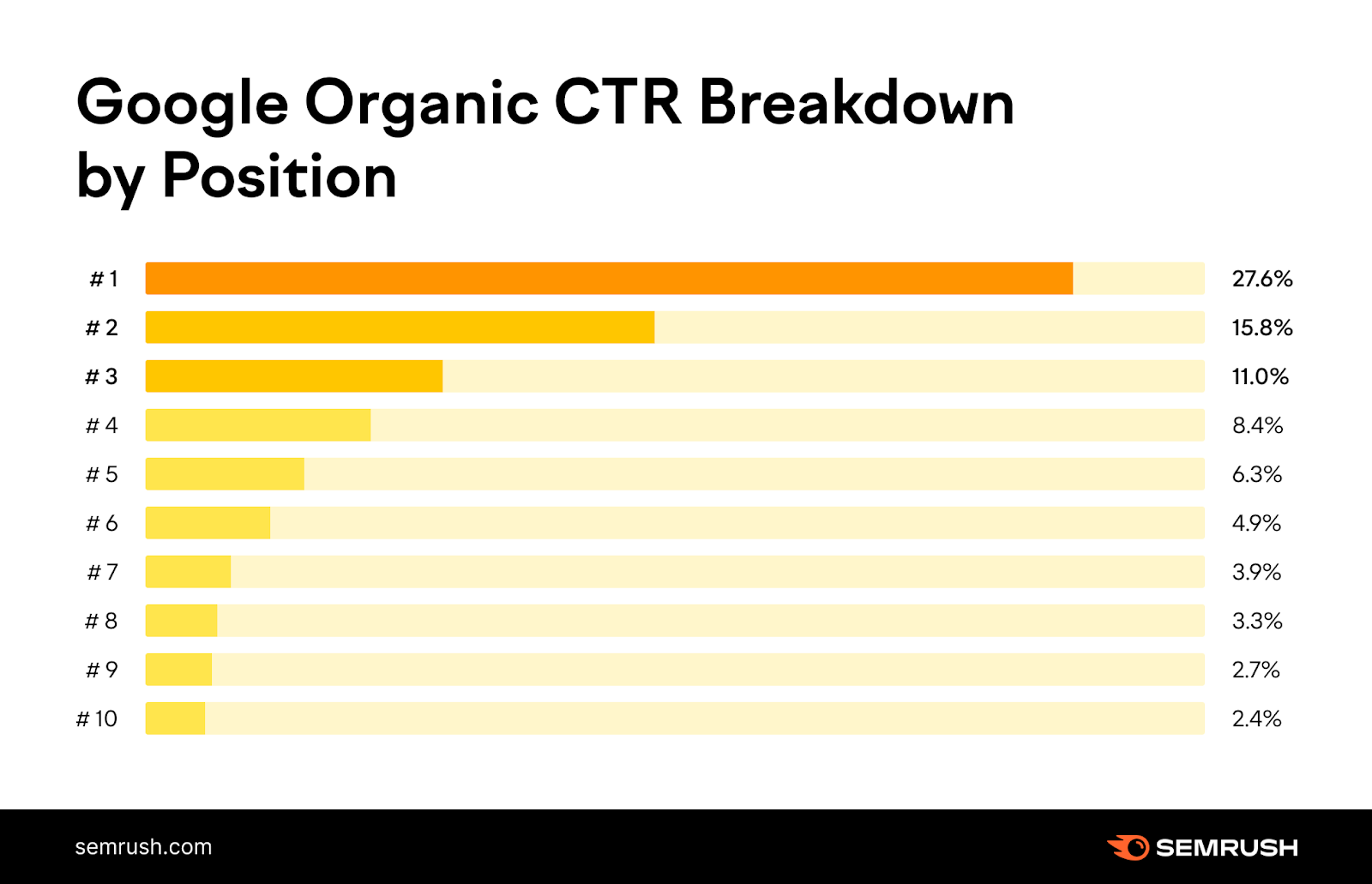
Source: Backlinko
There are five main components of SEO:
1. Keyword Research
Keyword research involves finding the terms and phrases people type into search engines when looking for information.
It helps you:
- Find high-value keywords (keywords most likely to attract users who are interested in your products or services) you can create content around
- Understand keyword intent so you can accurately meet searcher’s wants and needs
There are four types of keywords: navigational, informational, commercial, and transactional.
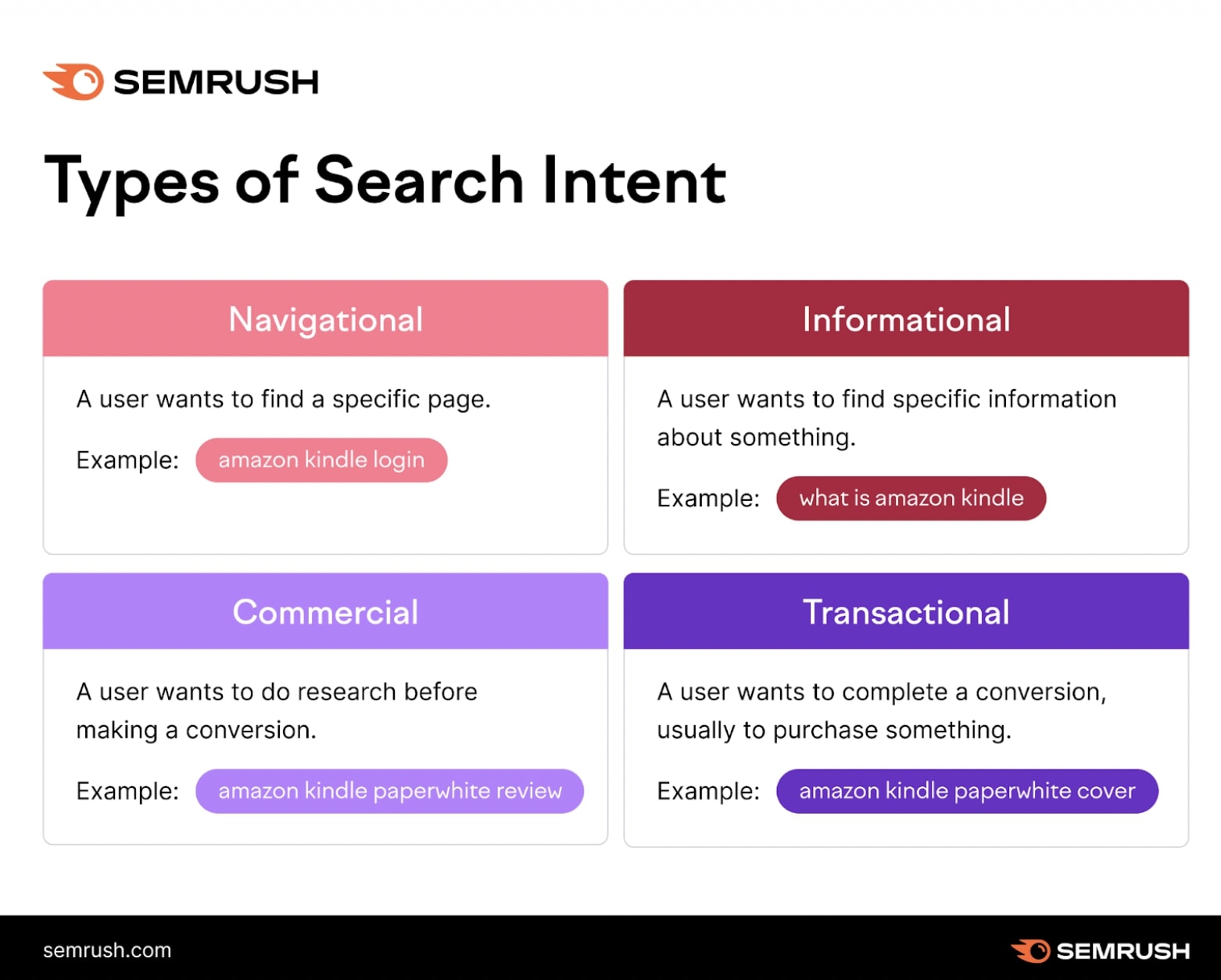
Ideally, you should match your keywords to your goals. So, if you’re looking for more organic traffic, focus on informational keywords that help users learn more about a topic.
Keyword research tools like our Keyword Magic Tool make it easy to find relevant keywords.
Open the tool, enter your seed keyword (a broad term related to your business), and click “Search.”

You’ll see a list of keyword ideas that can be sorted by different filters, including:
- Monthly search volume
- Search intent (the reason behind a user’s search)
- Keyword difficulty (KD %)—a measure of how difficult it is to rank in the top 10 for a given keyword
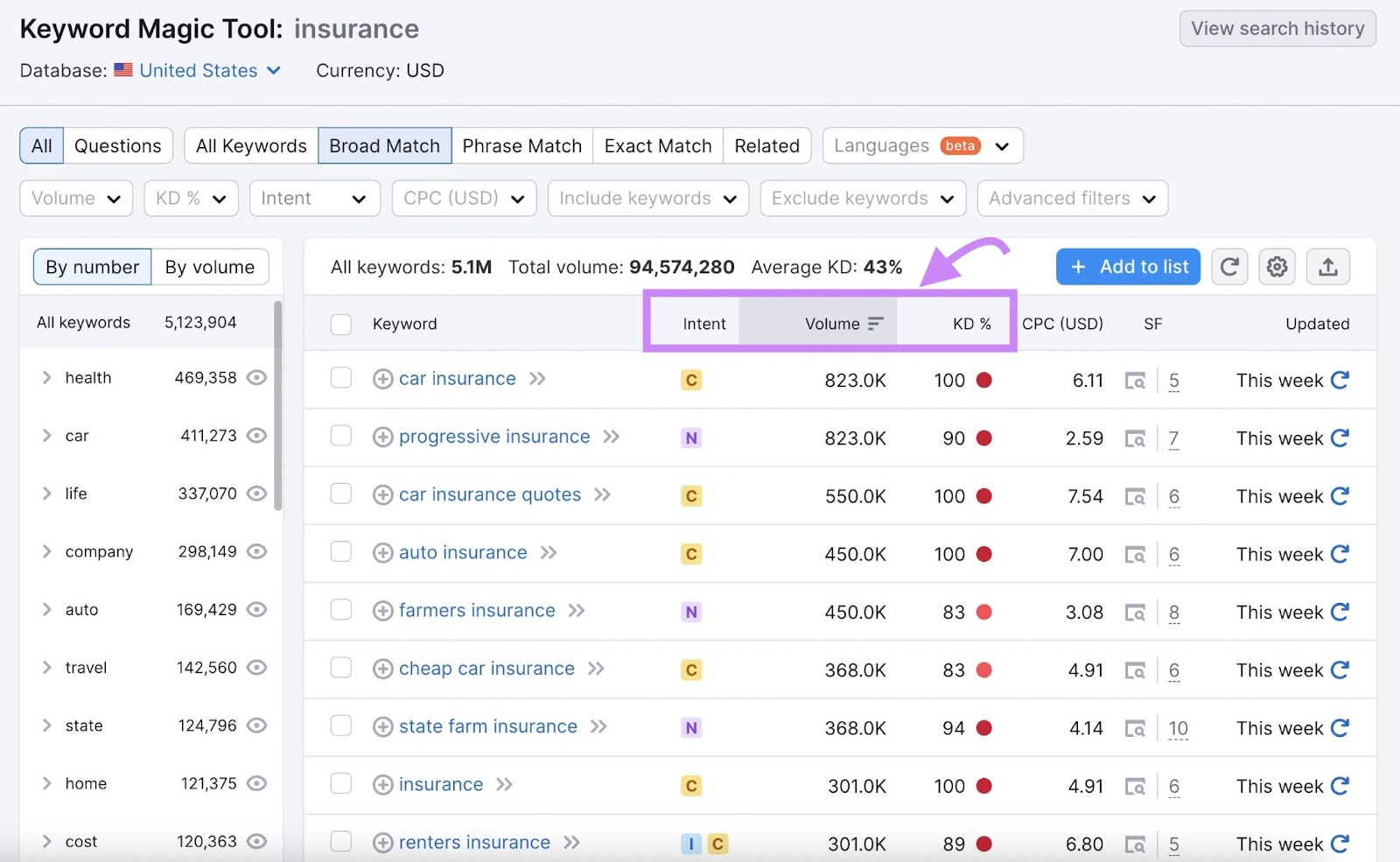
Look for keywords that are aligned to your particular niche. And keep both monthly search volume and keyword difficulty in mind. Because there could be some great opportunities if you find relevant options that have high search volumes and low difficulty scores.
You can also filter keywords by questions by clicking the “Questions” tab.
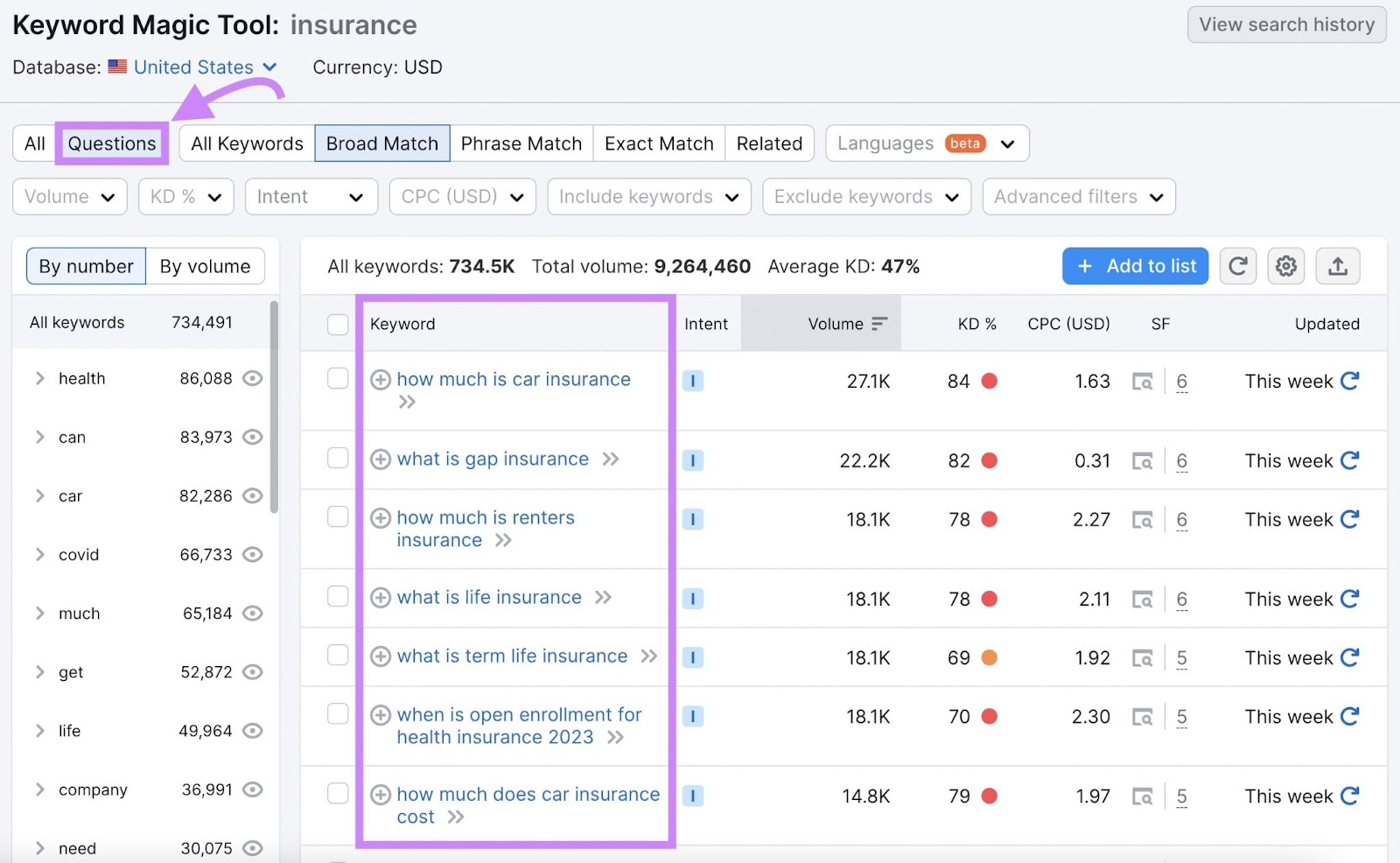
These search terms are great starting points for blog posts. Because you can give users answers you know they’re looking for. Or use those keywords as section headers to organize your content.
Check out our advanced keyword research guide to learn more about finding strategic keywords.
2. Content Creation
Content creation involves developing informative and/or entertaining materials intended for your target audience.
It can help you:
- Boost brand awareness
- Improve your site’s rankings
- Generate new leads and customers
There are a bunch of content formats. According to our State of Content Marketing report, videos, short-form articles, success stories, and long-form blog posts perform the best:
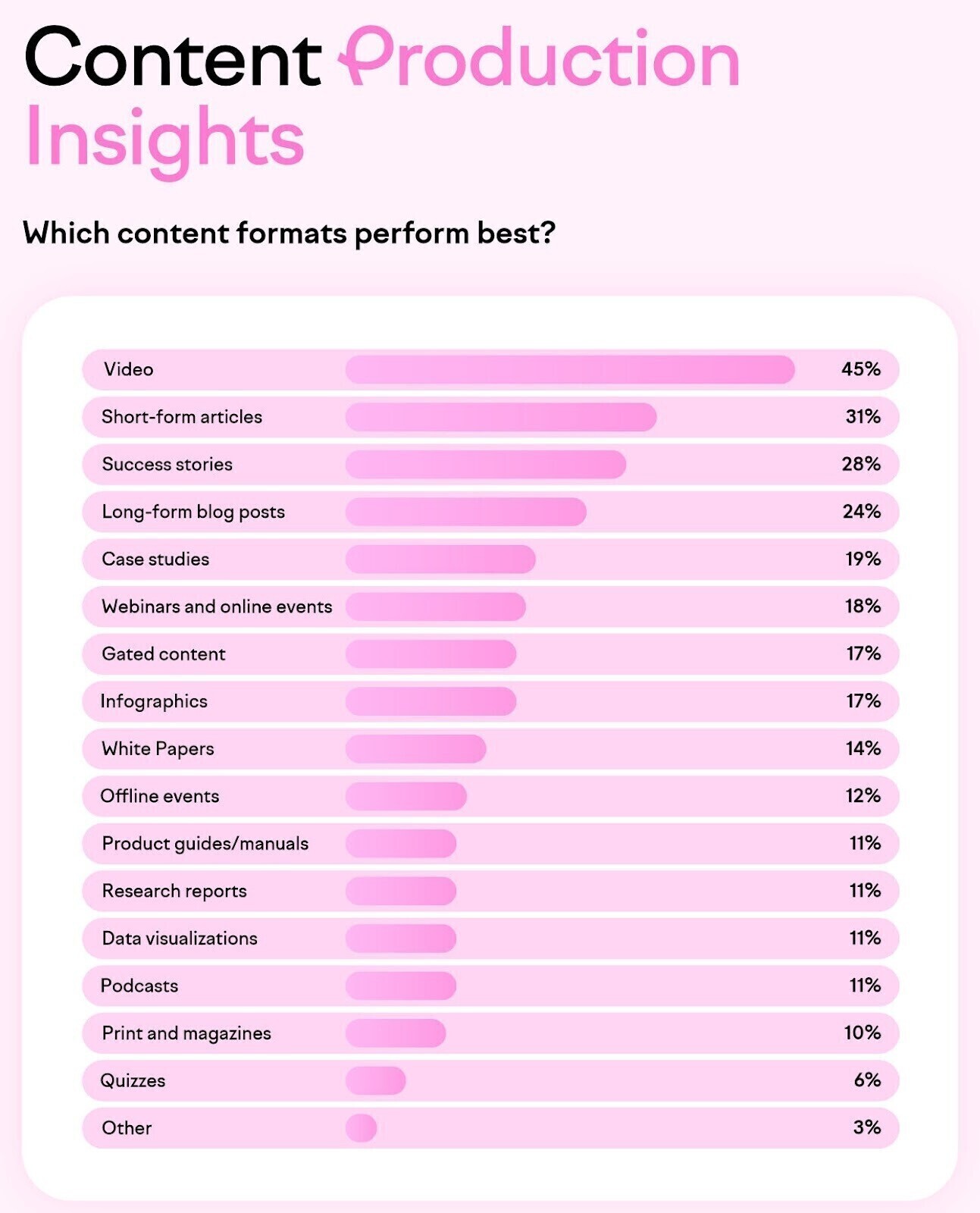
But make sure to align the content format with the user’s search intent and your topic.
Say you’re targeting “beginners guide to yoga.” The user is looking for in-depth but accessible knowledge. So, an ebook or long-form blog post would be ideal to walk them through the basics.
But in the case of “yoga poses for beginners,” it would be more helpful to publish a video that demonstrates the poses.
3. On-Page SEO
On-page SEO focuses on optimizing your webpages for search engines and users.
Improving your content quality and targeting the right keywords are big parts of on-page SEO. But it also includes factors like:
- Internal linking to connect pages within your site
- Using straightforward URLs
- Optimizing images and using descriptive alt text (the text that displays when an image fails to load and that’s read aloud by screen readers)
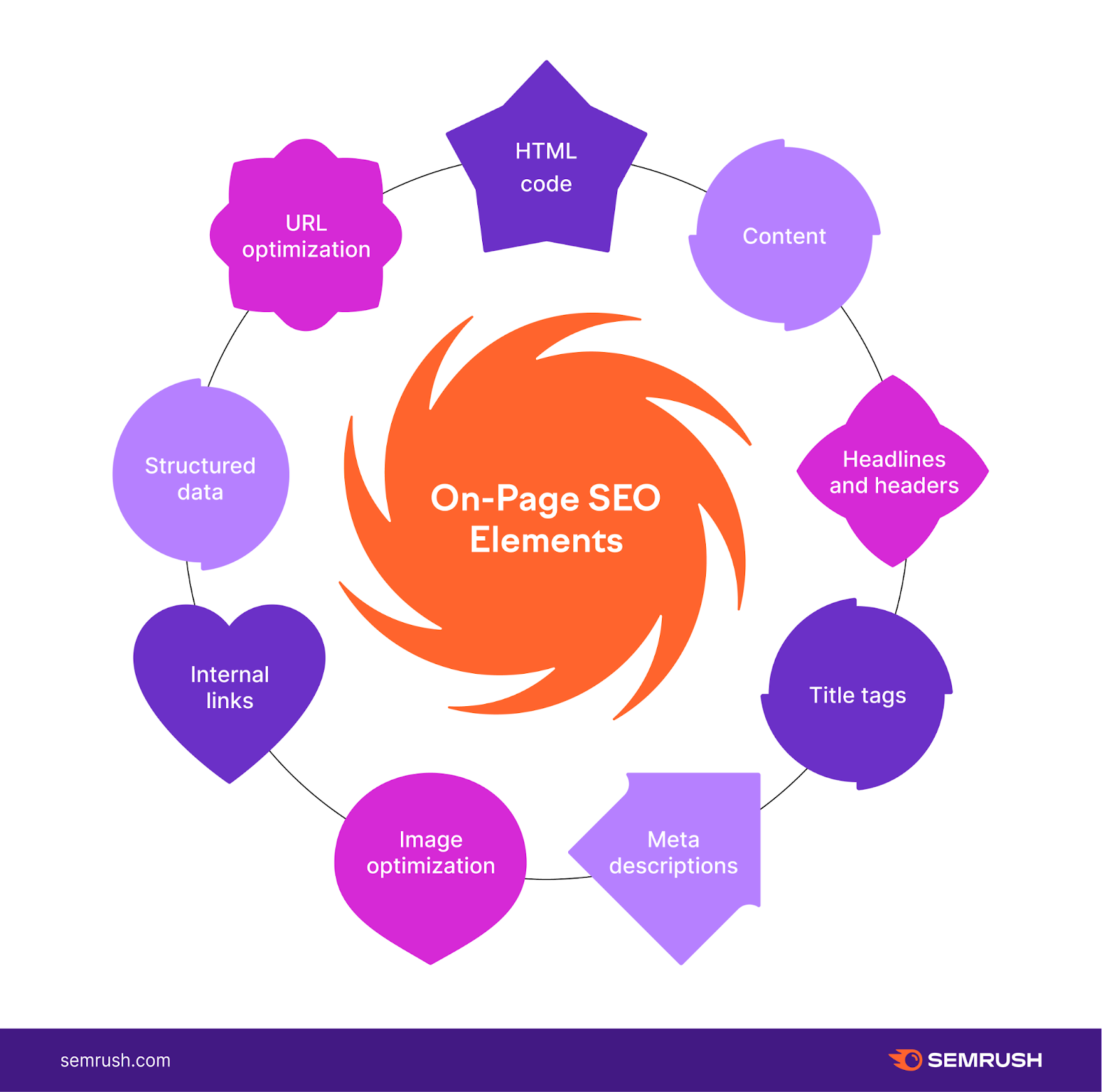
On-page SEO helps search engines understand your content better to determine whether it’s relevant to a particular query.
It also provides a better user experience (UX). Which can mean higher engagement, dwell time (how long users stay on the page), and conversion rates.
Try On Page SEO Checker to find ways to improve your pages.
Open the tool, enter your URL, and click “Get ideas.”

Follow the steps to complete the configuration.
Then, you’ll see the “Overview” report:
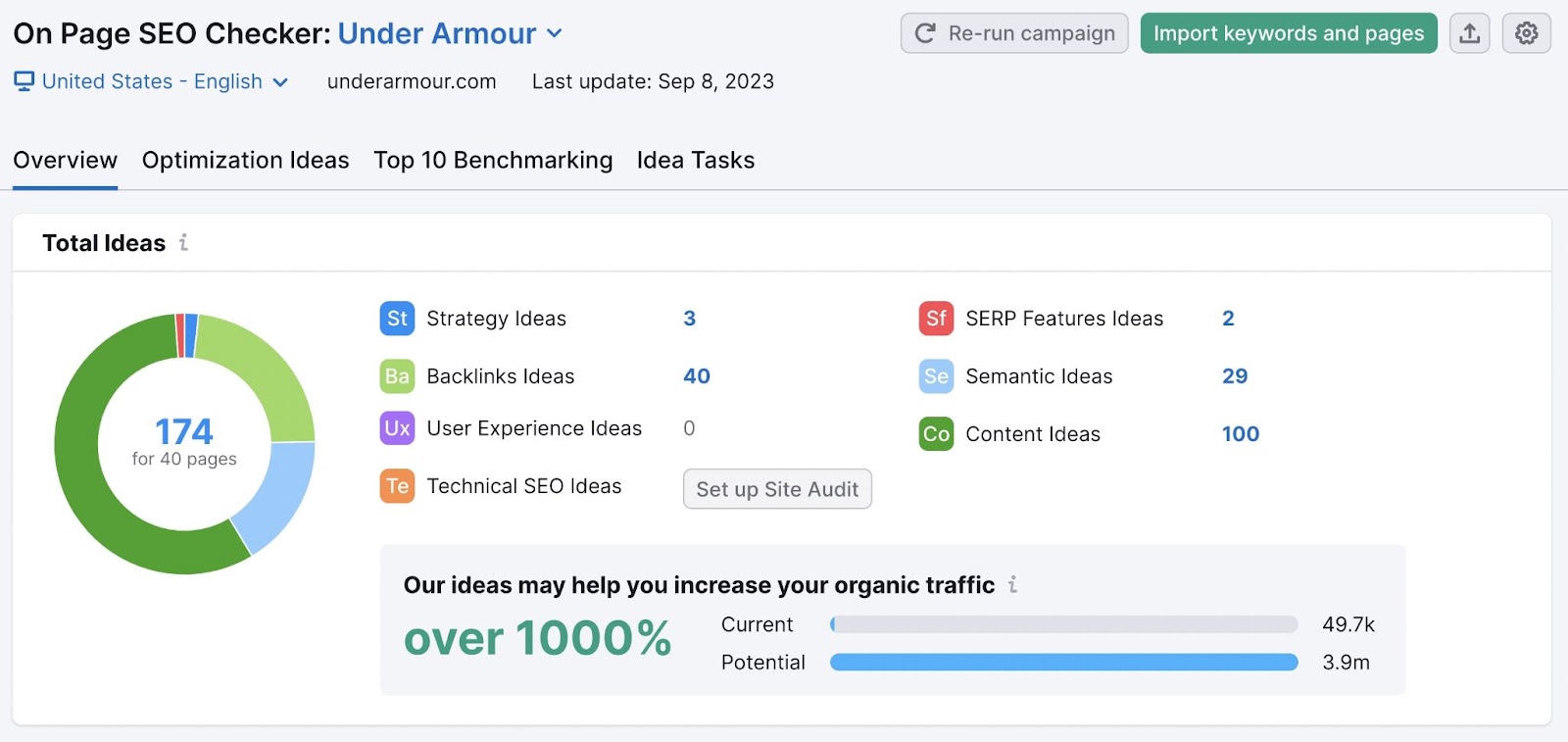
This report shows you the total number of suggested ways to boost your on-page SEO. And an estimate of how much traffic you can gain by optimizing your pages.
At the bottom of the report, you can dig into how to improve pages based on their priority ranking. Just click the “# ideas” button next to a specific URL.
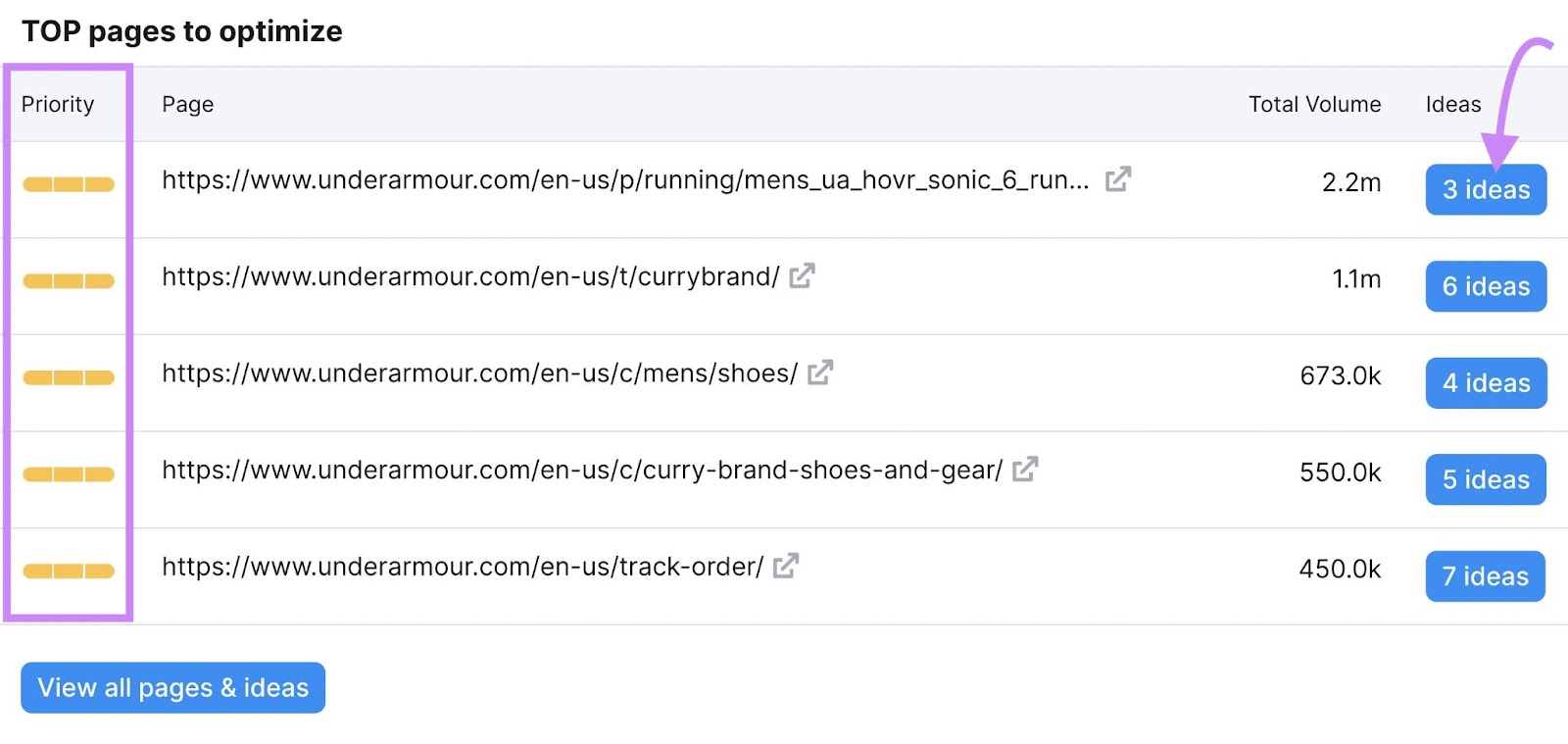
You’ll then see a list of suggestions to improve your:
And more.
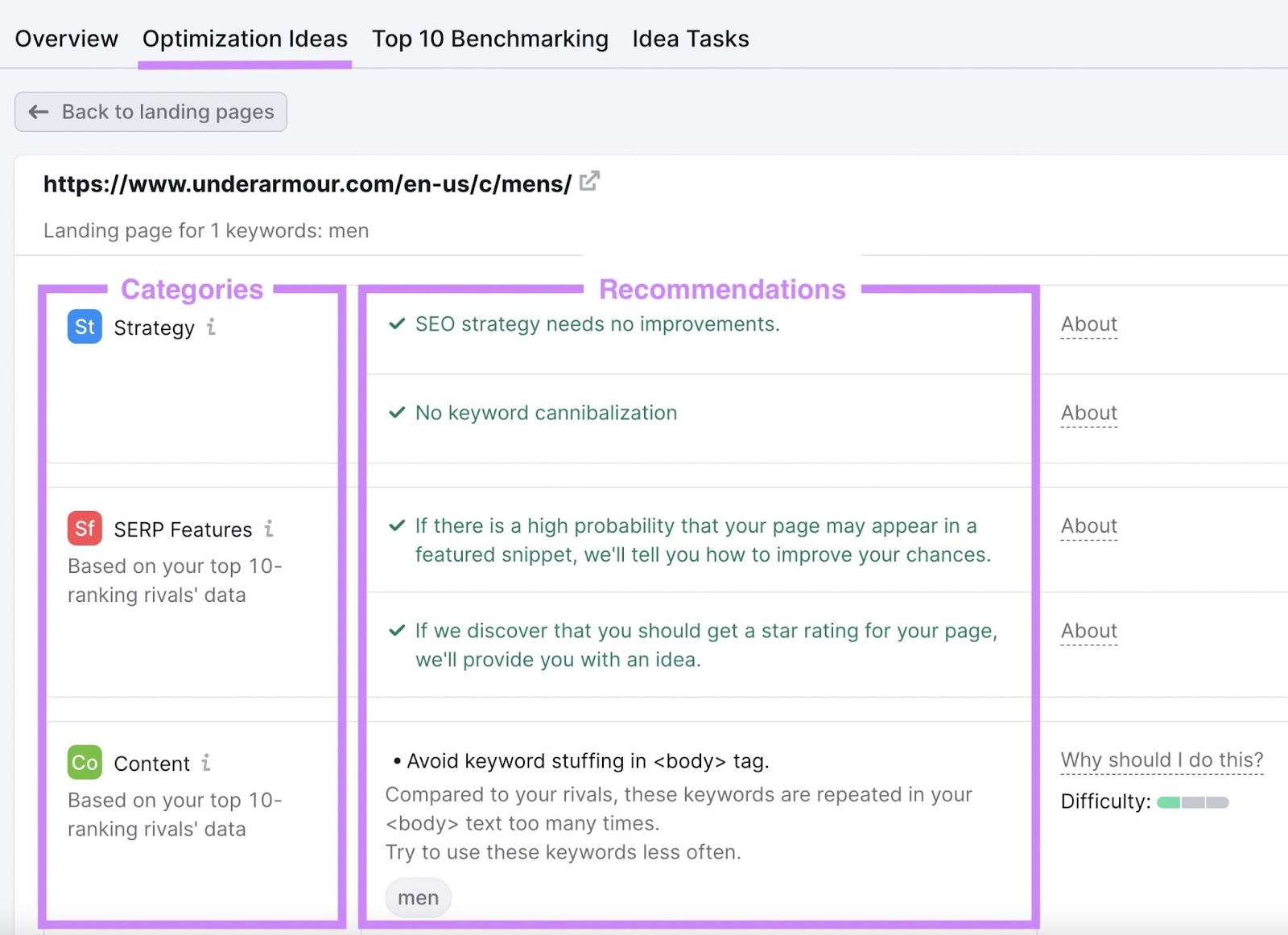
Start incorporating the suggestions for one piece. And then move to the next.
Further reading: On-Page SEO Checklist: The Complete Task List
4. Off-Page SEO
Off-page SEO entails activities taken outside of your own website that aim to boost your rankings.
It involves elements like:
- Getting backlinks (links from other sites that point to yours)
- Gaining brand mentions on different websites
- Doing guest blogging
- Acquiring reviews (for local SEO)
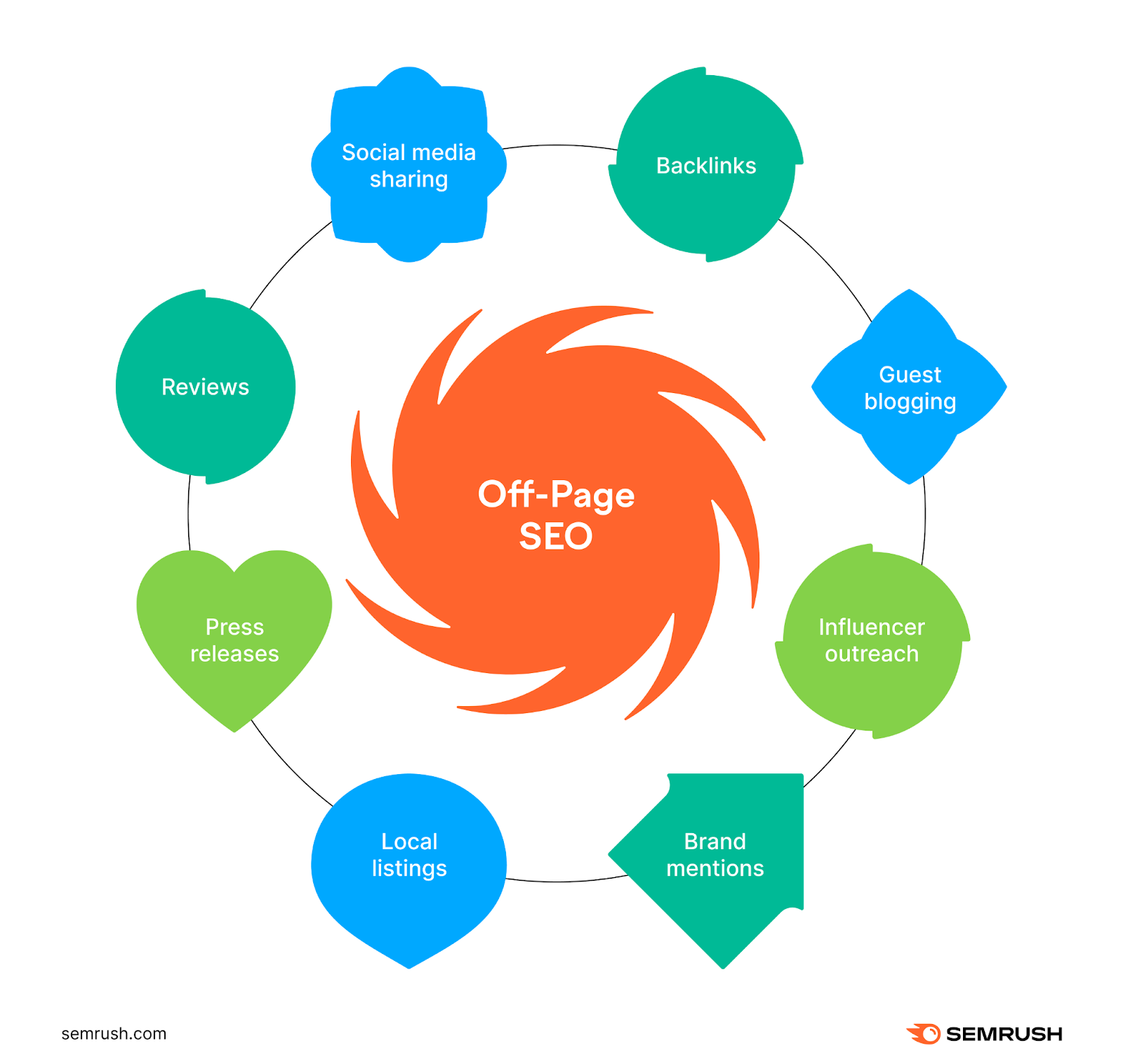
These activities tell search engines that your site is credible. As a result, your site is more likely to rank higher on SERPs.
You can find ways to improve your site’s off-page SEO by starting with a backlink audit.
Go to Semrush’s Backlink Audit tool, enter your domain, and click “Start Backlink Audit.”
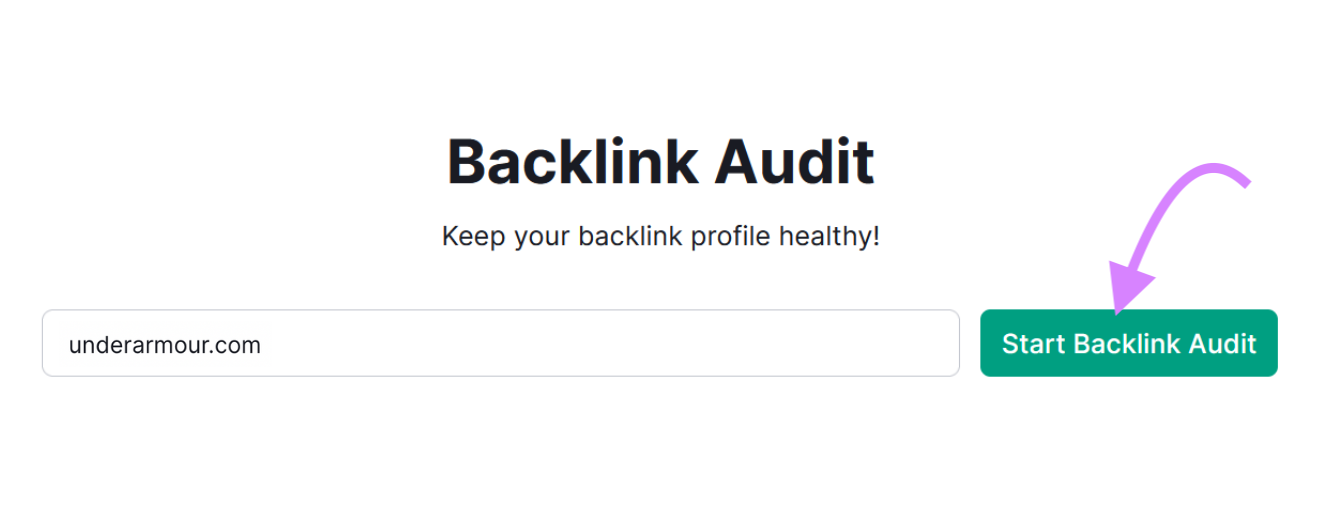
Follow the steps to complete the configuration.
Once the audit is done, you’ll see a high-level view of your site’s backlink profile in the “Overview” report:
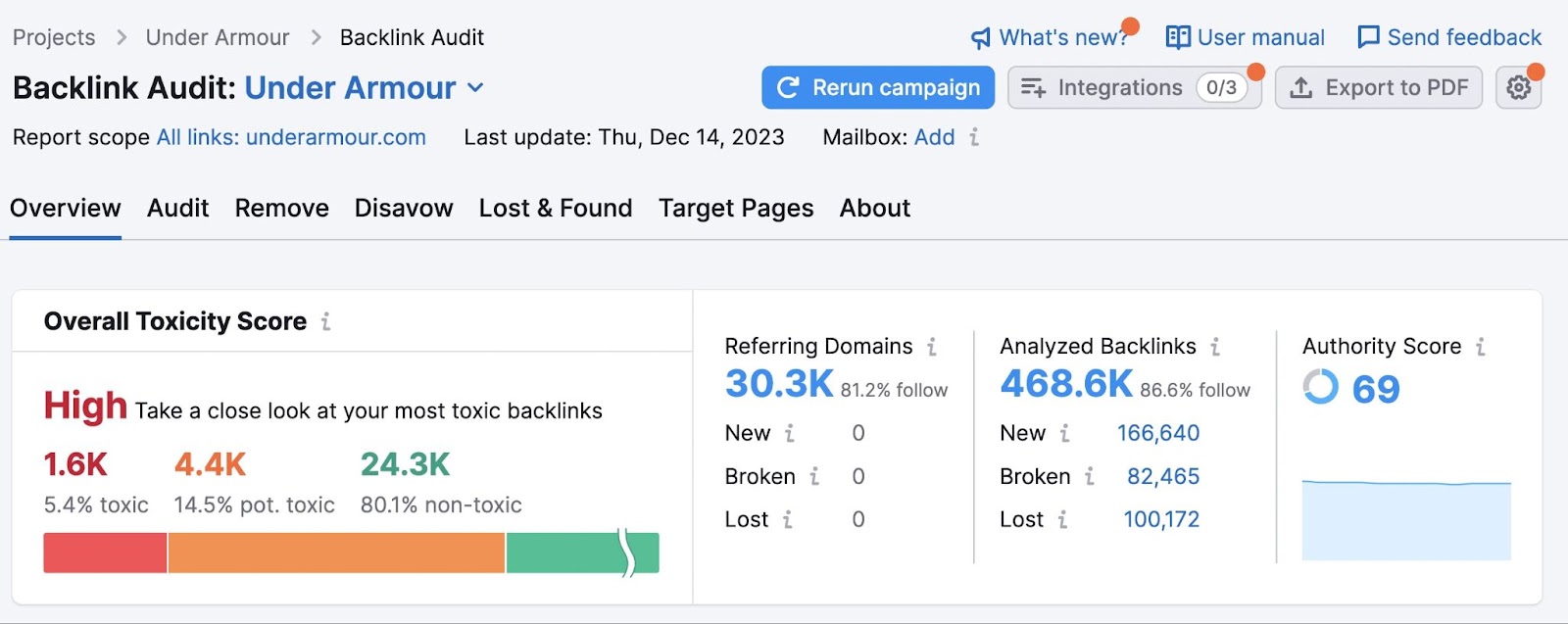
Click the “Audit” tab. Here, you’ll see all the backlinks pointing to your site.
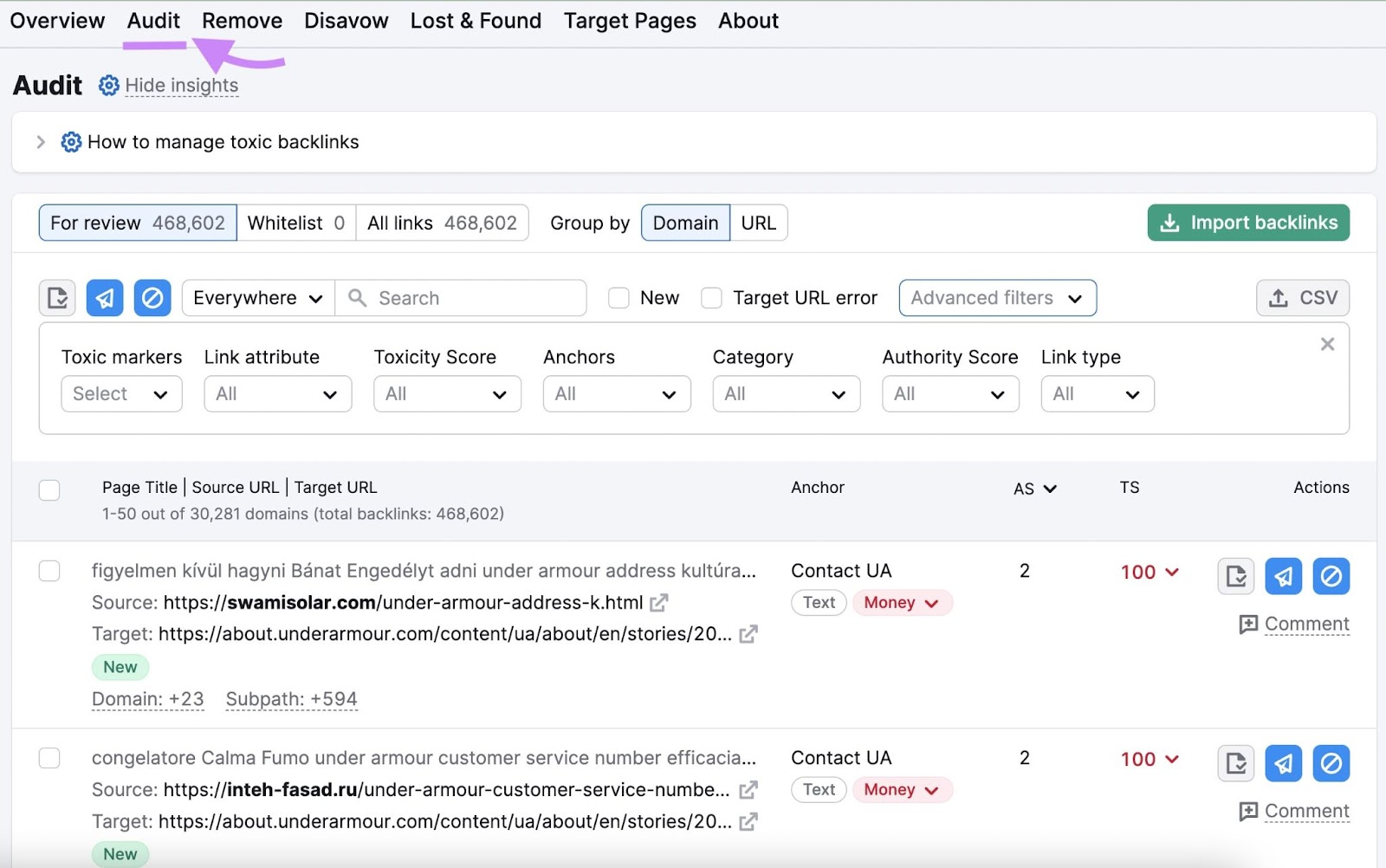
Review the backlinks. Specifically, look at the:
- Authority score (AS)—a measure of how reputable the linking domain is (you want this to be high)
- Toxicity score (TS)—a measure of how potentially harmful a linking page is (you want this to be low)
Google generally does a good job of ignoring bad backlinks. But if you’ve engaged in questionable backlink practices in the past and received a manual action (a penalty Google gives to sites that violate its spam policies), you may want to consider removing or disavowing any links with a high toxicity score.
Further reading: Off-Page SEO Checklist: Our Top 8 Tips
5. Technical SEO
Technical SEO is the behind-the-scenes work that optimizes your site for search engines. And also improves UX.
Technical SEO includes factors like:
- Having a clear sitemap
- Ensuring your site loads quickly
- Using HTTPS instead of HTTP for greater security
- Making your site mobile-friendly
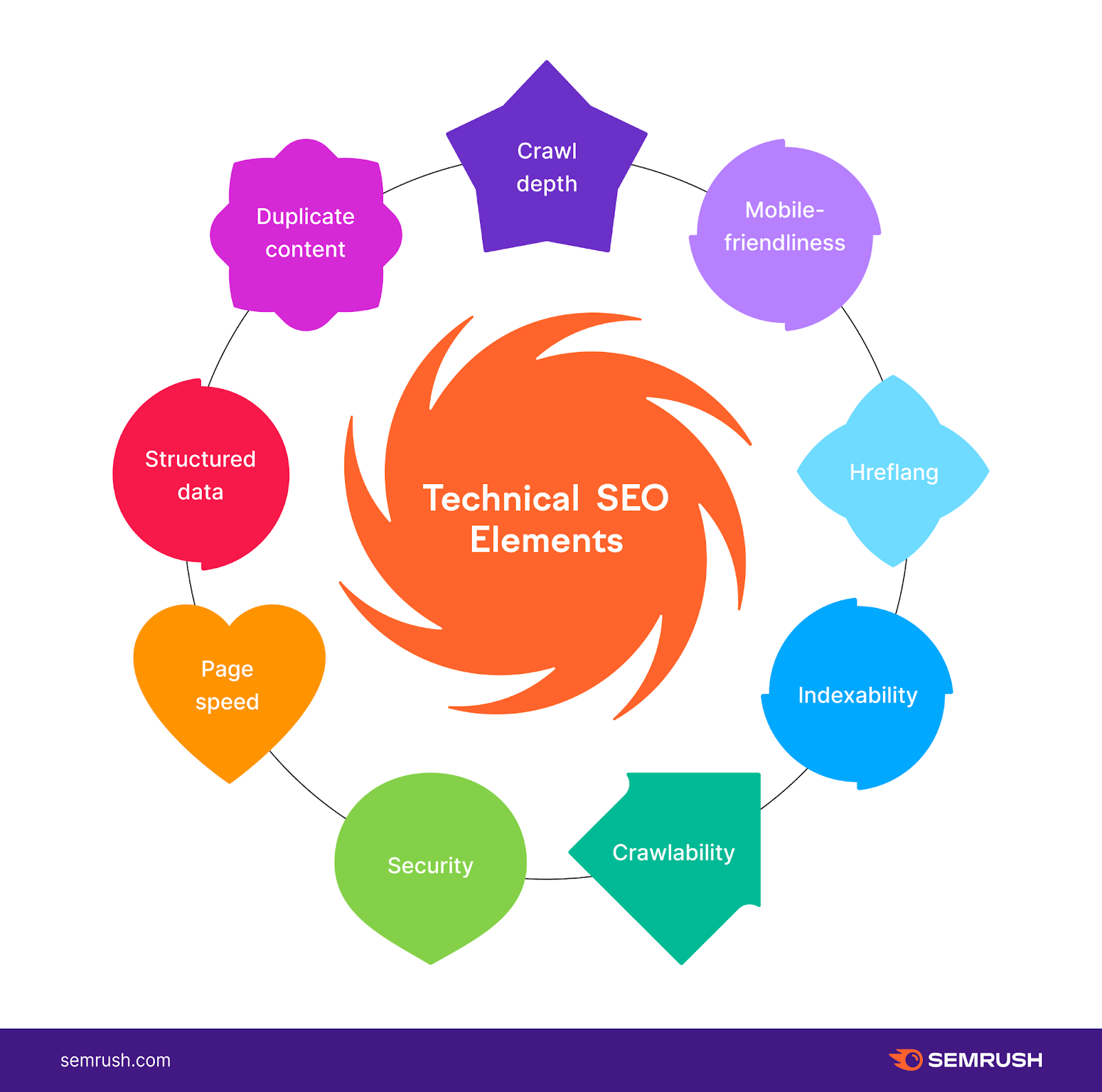
Getting the technical details right sets up your website for more success in search results.
Try Semrush’s Site Audit tool to identify any technical SEO issues on your website.
Open the tool and create a project first.

Configure the settings. And when you’re ready, click “Start Site Audit.”
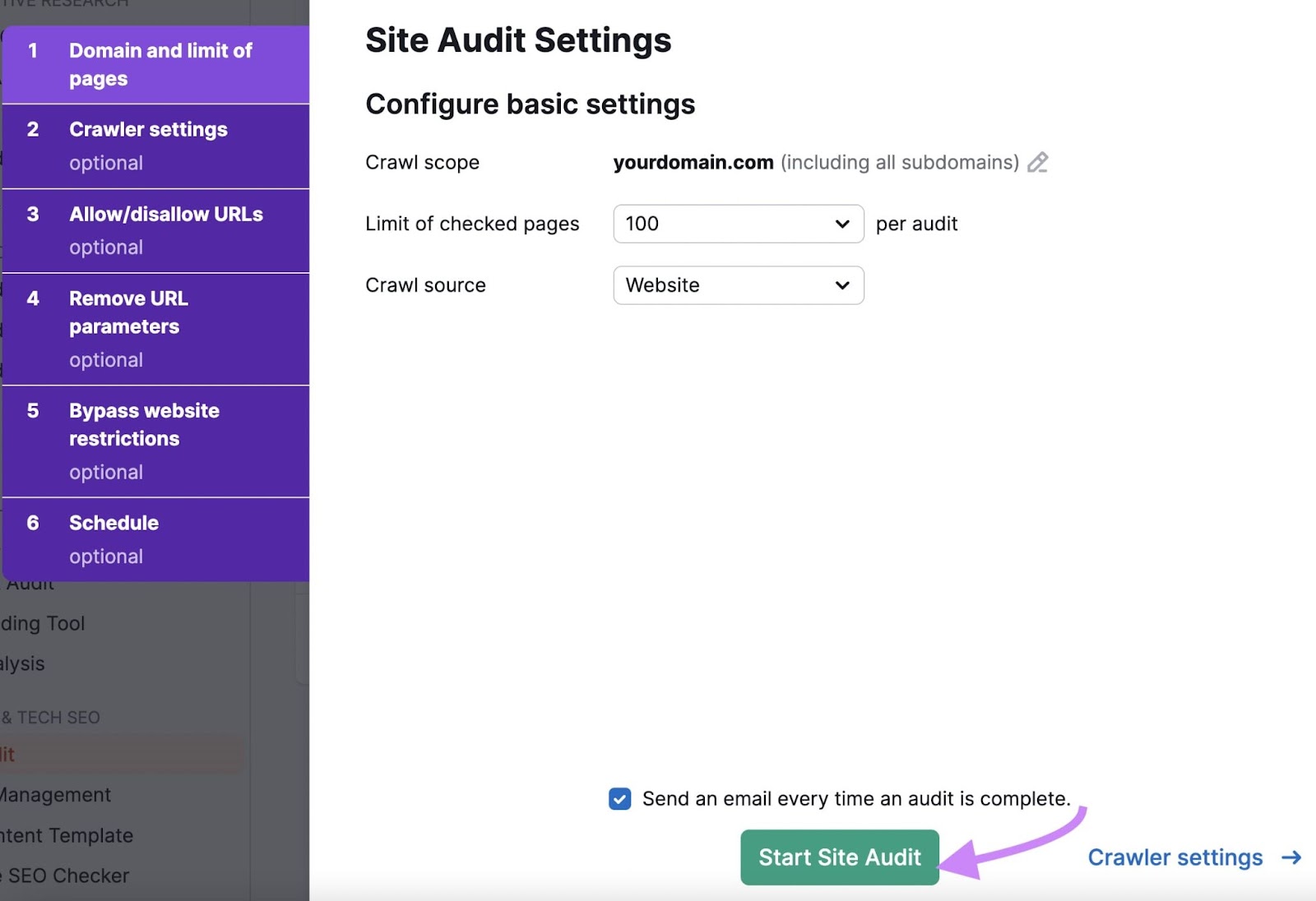
After your site has been audited, you’ll see an “Overview” report like this:
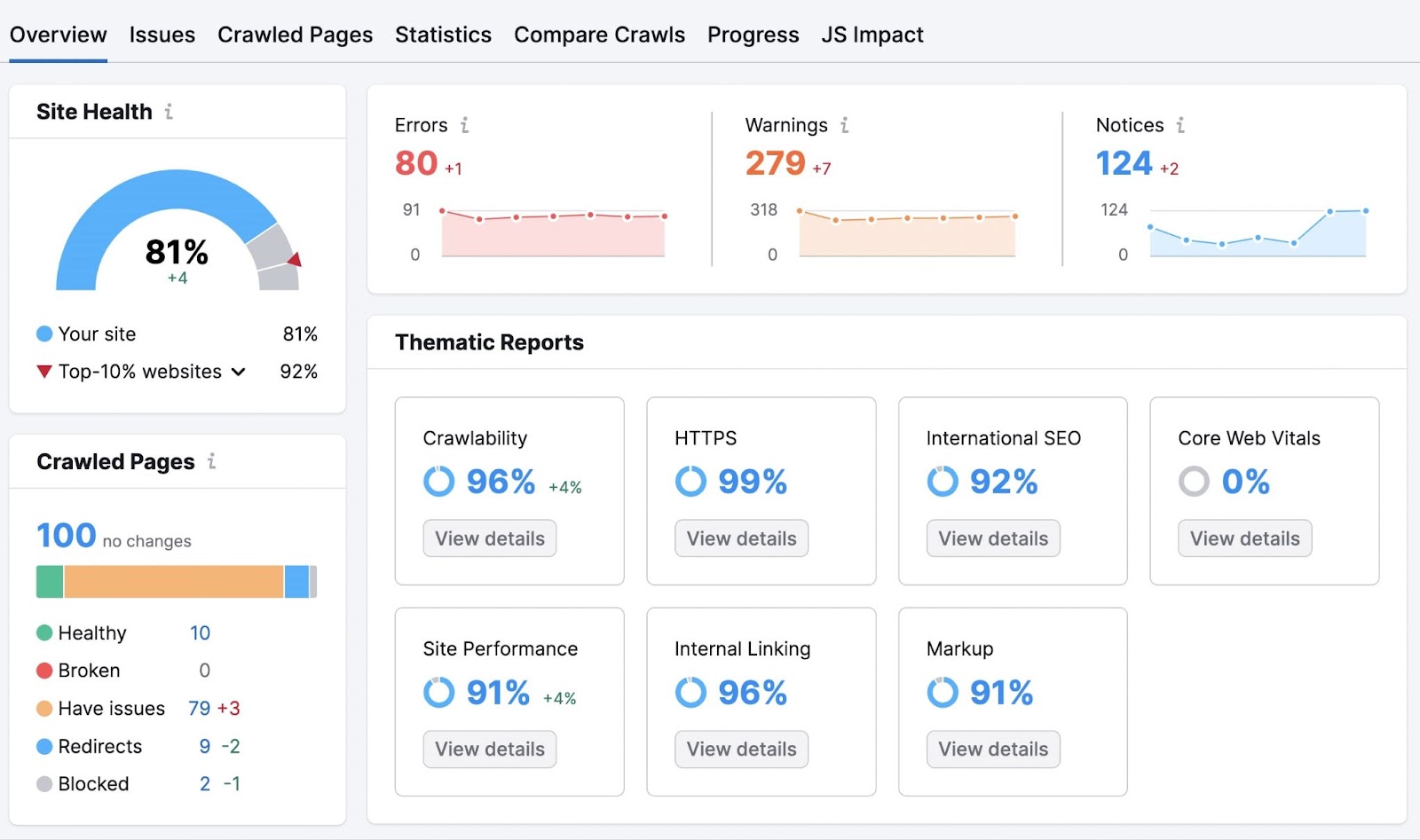
Click the “Issues” tab to see all the technical SEO problems found on your domain. And the number of each type of issue.
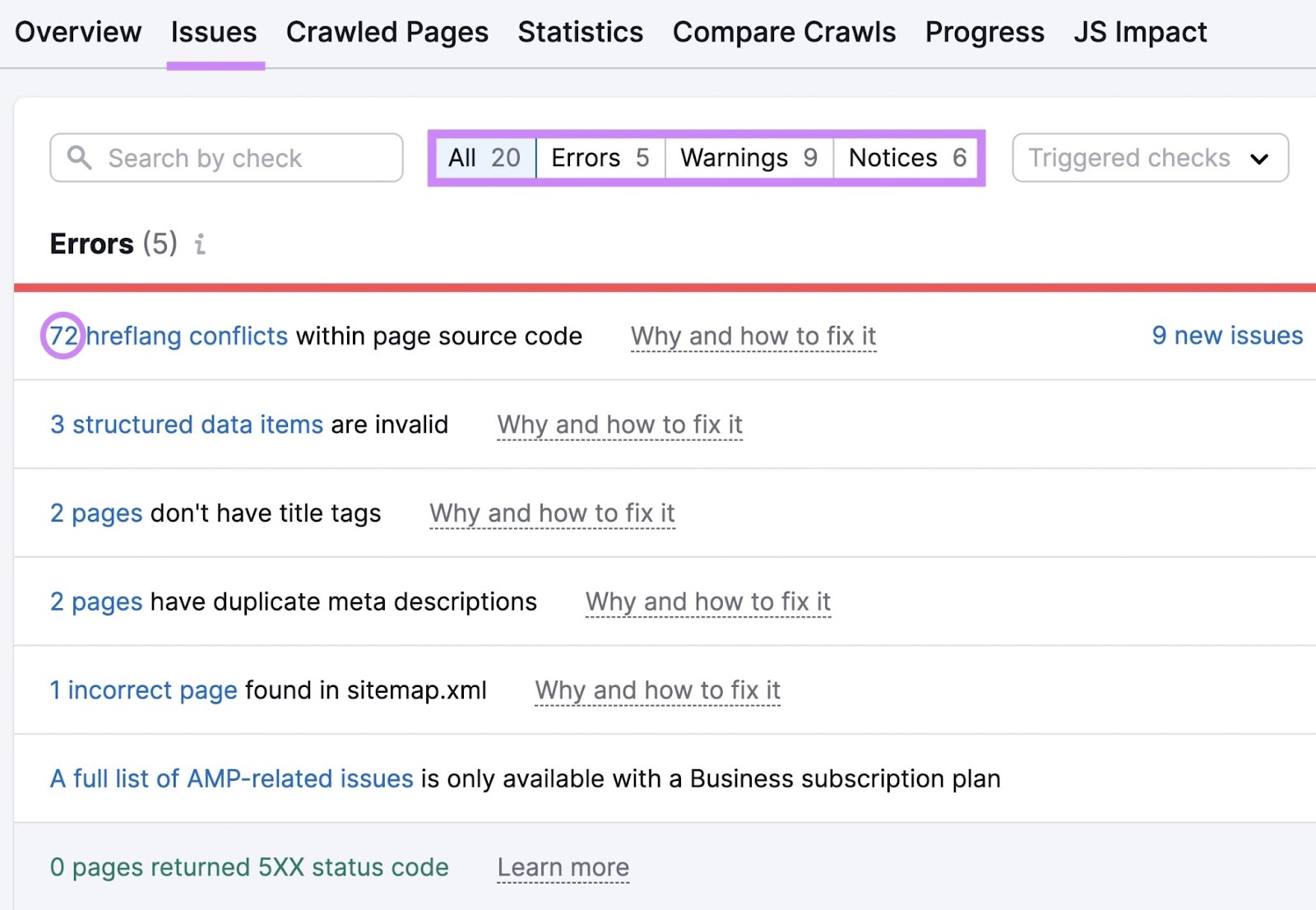
You can filter by three different categories of issues:
- Errors: The most severe problems
- Warnings: Medium-severity problems
- Notices: The least severe problems
Click “Why and how to fix it” next to any issue for a quick summary of the problem and a suggested solution.
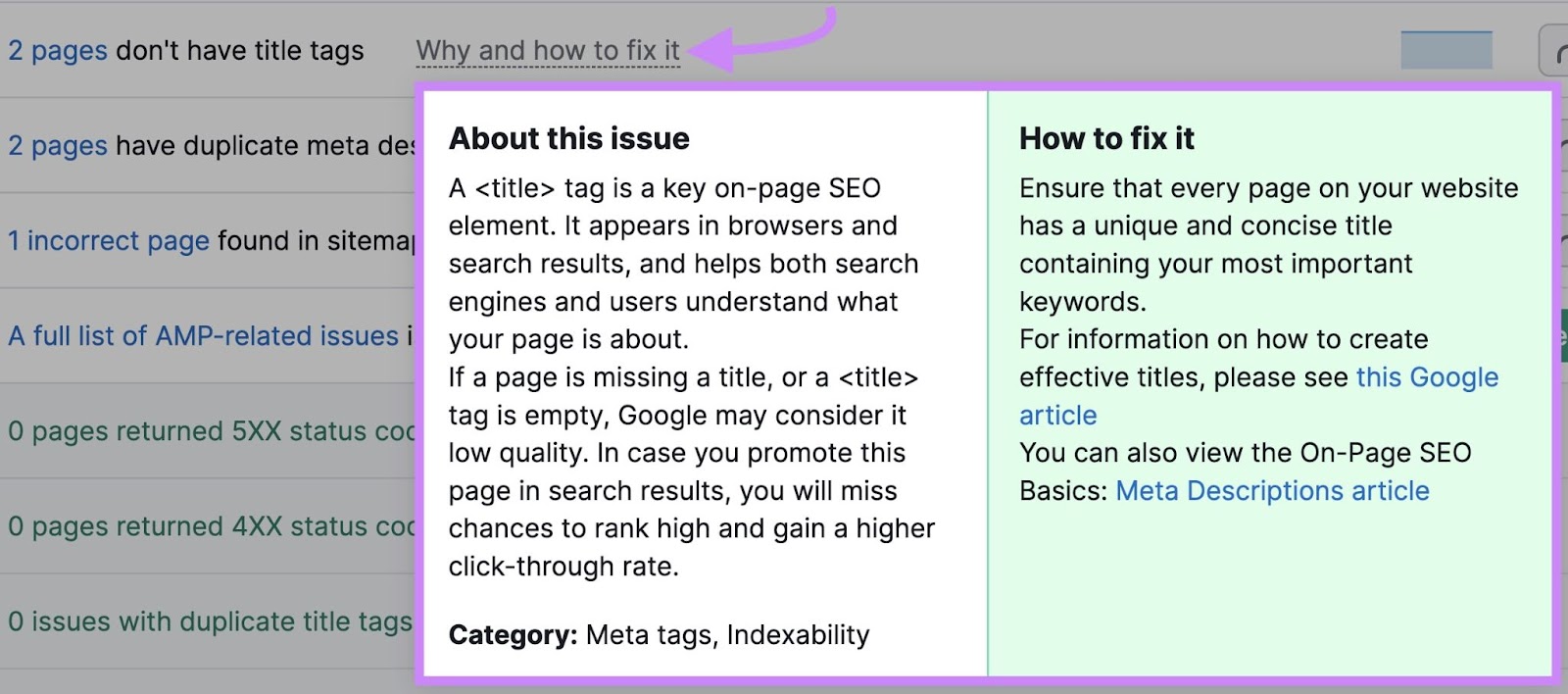
Focus on resolving the errors on your site first. Then, move to warnings and notices.
SEO Pros
It Can Be a Cost-Effective Traffic Source
Optimized pages that rank well provide a steady stream of traffic without the recurring costs associated with paid advertising.
Sure, there are investments in content creation, optimization, and SEO tools. But the traffic itself doesn’t cost you money to earn.
Plus, organic reach from SEO tends to grow over time.
If your site climbs higher in search rankings, it attracts more traffic without additional costs. Making your initial investment in SEO more rewarding in the long run.
It Allows You to Target Different Funnel Stages
SEO allows you to create a content ecosystem that addresses users’ needs at various customer journey stages. Meaning you can craft content that guides users closer to a conversion (i.e., taking the action you want them to take).
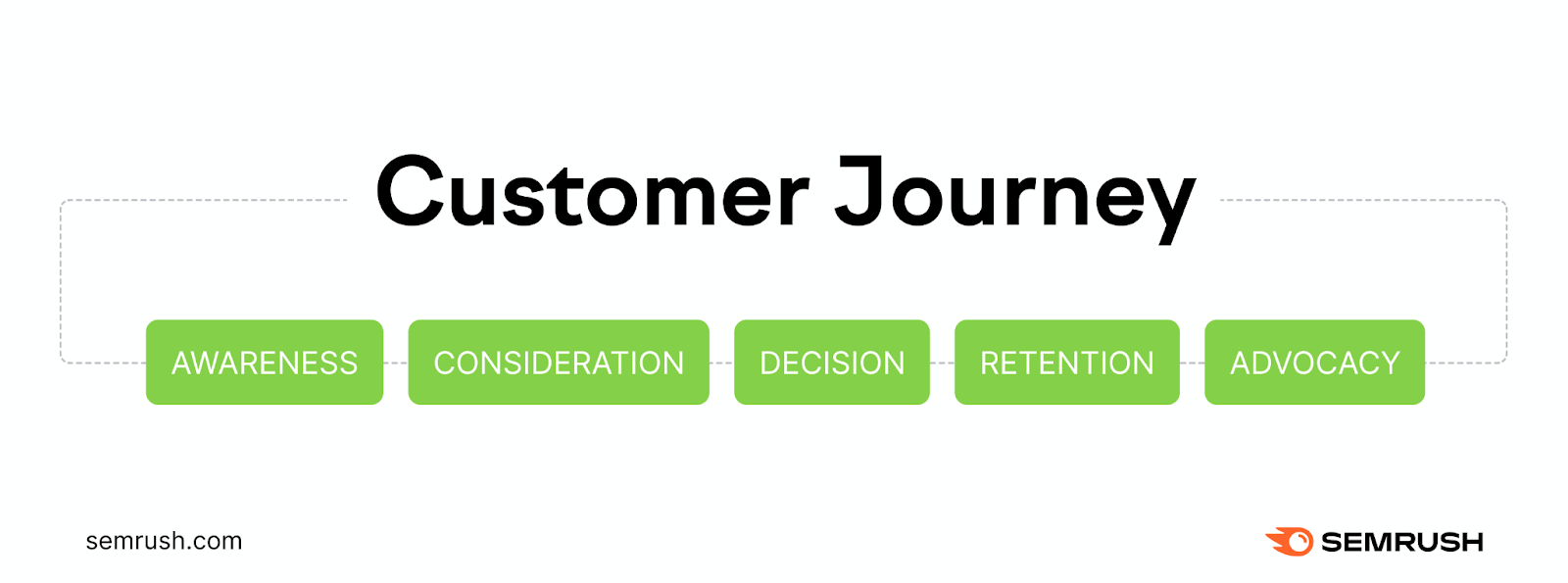
Here’s an example of how content at different stages may look for a gardening tool website:
- Awareness stage: A blog post titled “5 Essential Tips for Beginner Gardeners,” introducing newcomers to gardening basics
- Consideration stage: An in-depth article called “Choosing the Right Garden Tools: A Buyer’s Guide” to help readers evaluate their options
- Decision stage: A product review page with detailed comparisons of different gardening tool brands, aiding in the final purchase decision
- Loyalty stage: A series of how-to guides and maintenance tips for gardening tools, encouraging repeat visits and ongoing engagement
It’s particularly useful in the stages that influence purchasing decisions. Because you can move users closer to a decision in the same way you do with ads, but without the same cost.
It Can Increase Brand Awareness and Consumer Trust
Securing top positions on SERPs gets people more familiar with your brand. Because they’ll start to see it more and more when searching.
This can help you gain more credibility and establish your brand as a trusted authority.
This consistent visibility means that even when users are in the early marketing funnel stages, they already know and trust your brand. This can potentially influence their future purchasing decisions.
Case in point: In its 2023 Trust Barometer report, Edelman found that 59% of surveyed consumers are more likely to buy a new product from a brand they trust regardless of price.
SEO Cons
It Requires a Significant Time Investment
SEO is a marathon—not a sprint. It takes consistent effort over months to see significant results.
You’ll spend a lot of time researching keywords, creating content, optimizing your site, and refining your SEO strategy. And a former Google employee even mentioned it can take four to 12 months to see an impact.
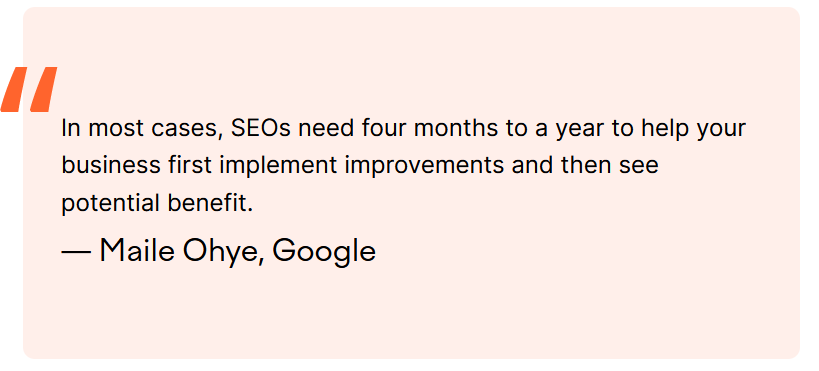
This can be a downside for businesses needing quick results. Because SEO won’t deliver an instant traffic boost.
It Changes Frequently
SEO isn’t a set-it-and-forget-it task. You have to regularly update your site and content to stay in line with search engine algorithm changes.
This can be demanding for those with limited time or expertise.
Further reading: What Is the Future of SEO in 2024? 8 Critical SEO Trends to Know
It Can Be Difficult to Compete with Established Brands
Competition is high in SEO—especially for high-volume keywords. And well-known brands often have the upper hand because of their resources.
According to a Detailed report, 16 companies (that own at least 562 individual brands across niches like pets, tech, food, and sports) clock 3.7 billion clicks every month. They dominate Google results.
So, it’s tough for smaller or newer sites (that have lower website authority) to rank highly for the same keywords larger brands are targeting.
It Comes with Penalties for Bad SEO Practices
If you don’t follow search engine guidelines, you risk penalties that can drop your site’s rankings or remove them altogether.
Practices like using irrelevant keywords, buying backlinks, or duplicating content can backfire. Google can flag that you’re trying to unethically manipulate rankings, which compromises the credibility of your content.
And recovering from penalties can be a long and challenging process, sometimes requiring a complete overhaul of your SEO strategy.
Check out our guide on fixing and avoiding Google penalties to learn more.
What Is PPC?
PPC is an advertising model that involves paying a fee each time your ad is clicked. Search ads are a particularly popular form of PPC.
Below is a Google ad that appears for the keyword “buy pet food.” Which is noted as an ad with the “Sponsored” label.
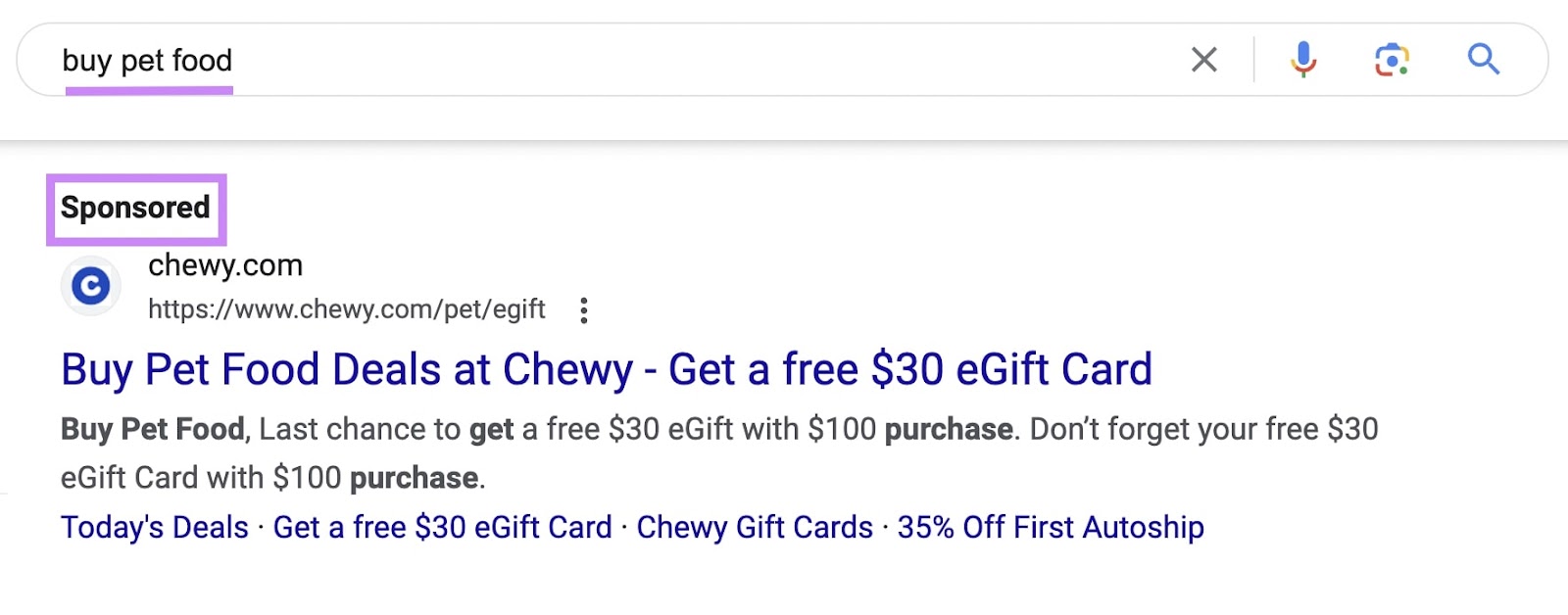
The core benefits of PPC are immediate visibility and traffic. Making it ideal for lead generation and sales campaigns.
There are five main components of PPC:
1. Keyword Selection
Like in SEO, selecting the right keywords is crucial in PPC advertising.
You want to choose keywords that:
- Are highly relevant to your ads and landing pages
- Have enough search volume to drive traffic
- Aren’t so competitive that the cost is beyond your budget
Start by brainstorming a list of terms closely related to your products or services.
Then, use a tool like Semrush’s Keyword Magic Tool to research search volumes and get suggestions for additional keywords.
Look for terms that match a search intent aligned with your campaign’s goals. So, if you’re looking to drive sales, opt for transactional keywords.
You can use the tabs at the top to filter for different keyword variations. To uncover more options that could work well for your campaign.
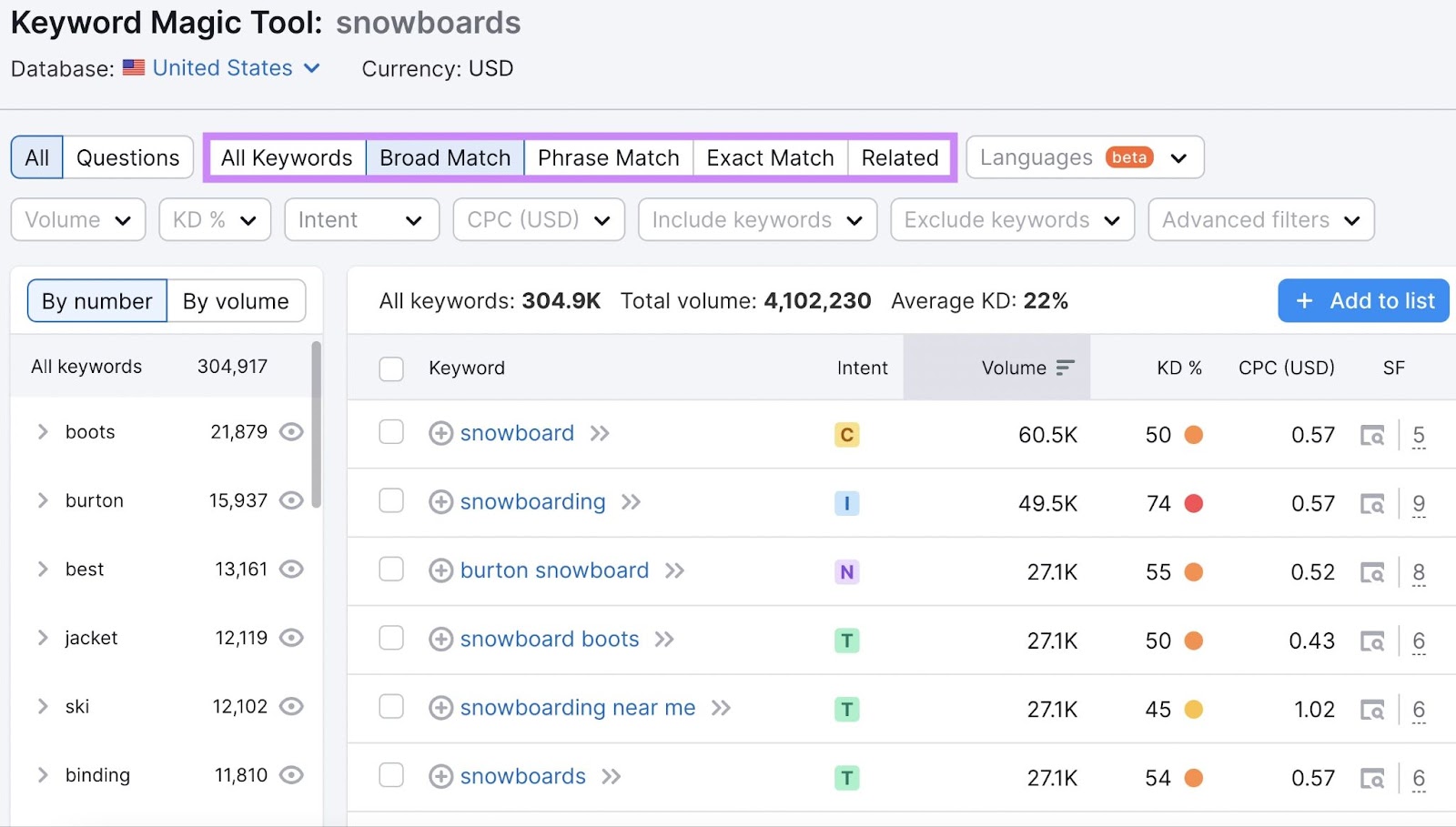
Keep in mind that the more aligned your keywords are with your audience’s intent as well as your ad copy and landing pages, the higher your Quality Score in Google Ads will be.
Quality Score is a metric Google Ads uses to evaluate your ad’s quality. A higher score can lead to higher ad positions with a lower cost per click (CPC).
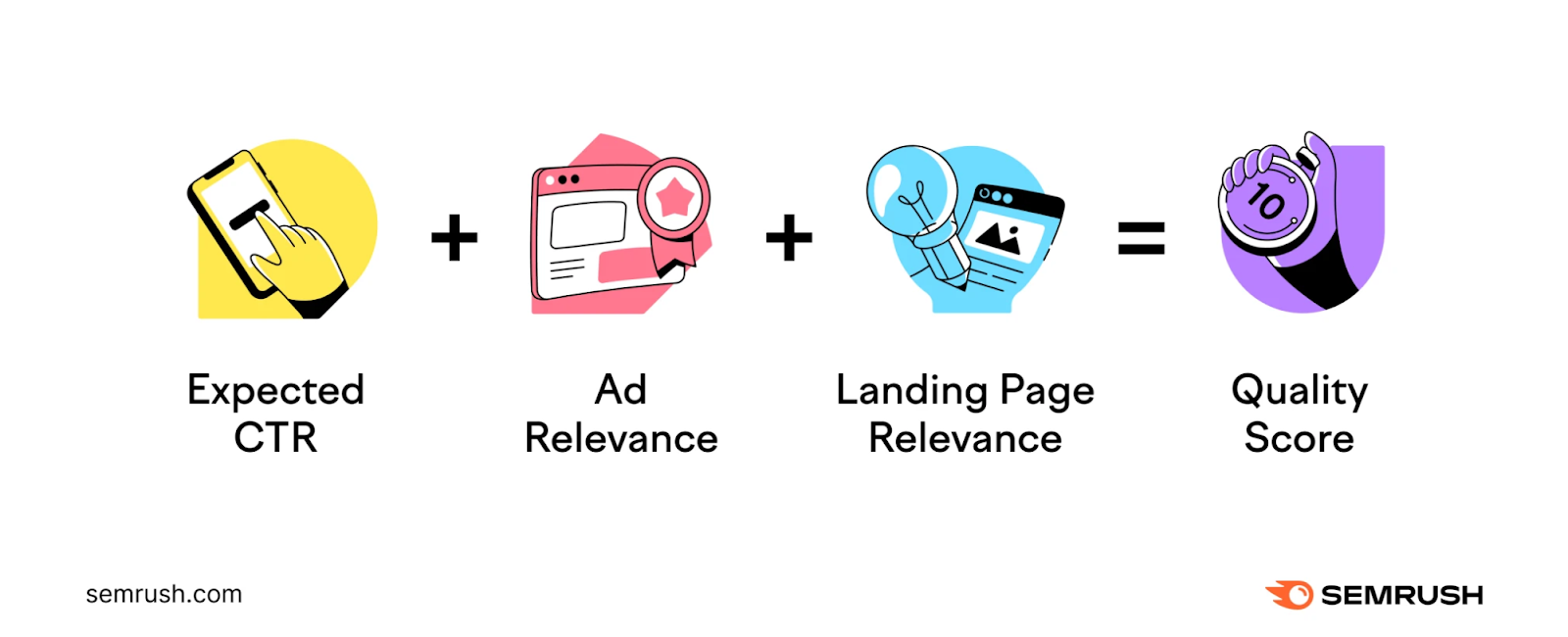
2. Bidding
This key step involves choosing the maximum amount you’re willing to pay for each click on your PPC ads.
Your bid will then be entered in a real-time ad auction to compete against others bidding on the same keywords. The outcome of this auction determines whether your ad appears and where it’s positioned on the SERP.
A higher bid can lead to a higher ad position, but it’s not the only factor. Search engines also consider the relevance of your ad, the quality of your ad, etc.
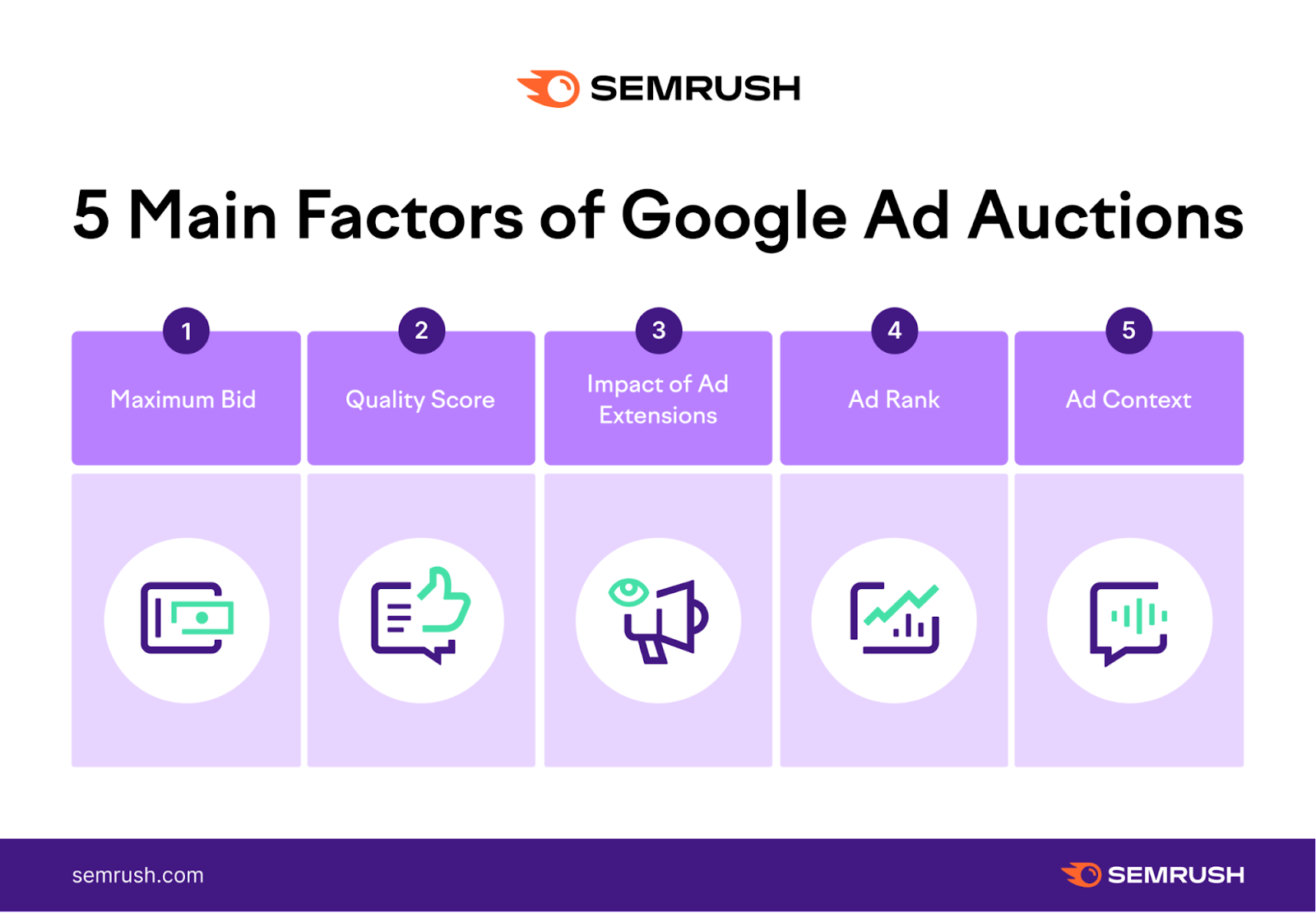
You won’t always pay your maximum bid. You’ll often pay less, depending on a number of factors.
Ultimately, you have to balance spending enough to get your ad seen and not overspending on clicks that won’t drive results.
3. Audience Targeting
Effective audience targeting in PPC helps you place your ads in front of the people who are most likely to be interested in them.
You can target audiences based on specific characteristics, such as:
- Demographics: Age, income level, education, and more
- Geographics: Country, city, or even a specific radius around a location
- Interests: Preferences, hobbies, and behaviors that might align with your product or service
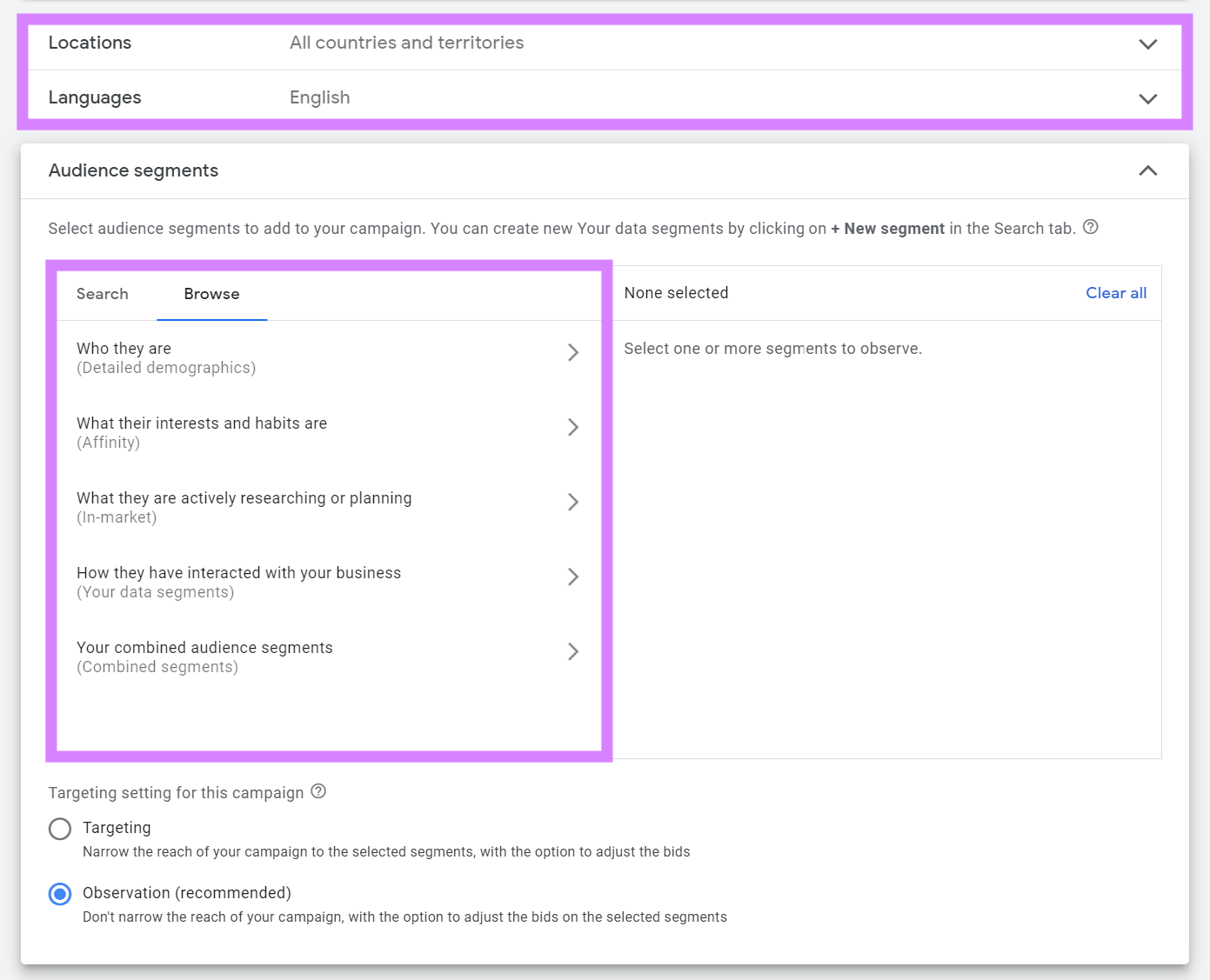
Selecting these criteria in your PPC campaign settings makes it more likely that your ads will get in front of users who fit your ideal customer profile. Which helps in using your budget optimally and increasing the chances of attracting attention from the right people.
To learn more about your target audience, try Semrush’s One2Target tool.
You can add up to five of your competitors’ domains. And get information about their audiences’ demographics, socioeconomics, and behavior.
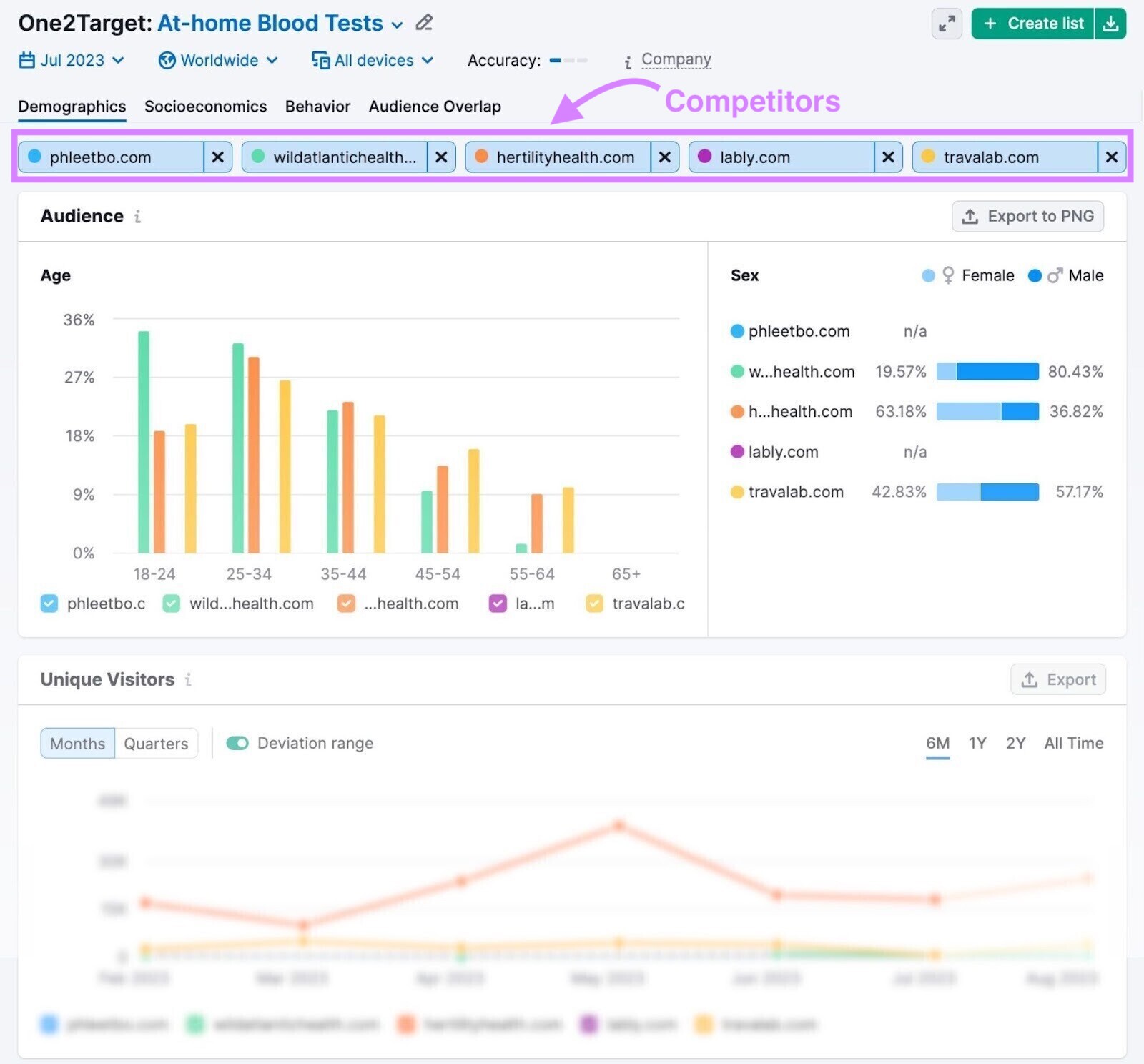
And note that you can leverage retargeting in ads as well. Which involves targeting people who’ve previously visited your site or interacted with you on social media.
4. Ad Copywriting
The words you use make or break whether someone clicks on your ad.
You need to successfully:
- Convey your message: The ad must communicate what you’re offering and why it’s valuable to the customer
- Match search intent: The ad should align with what the user wants. If they search for “best running shoes,” your ad should talk about features that make your shoes the best.
- Encourage action: The ad should include a clear invitation for the user to do something like visit your website or make a purchase
And you need to do all this in a very small amount of space. Because search ads have character limits.
Headlines can be no longer than 30 characters. And descriptions must be 90 characters or less.
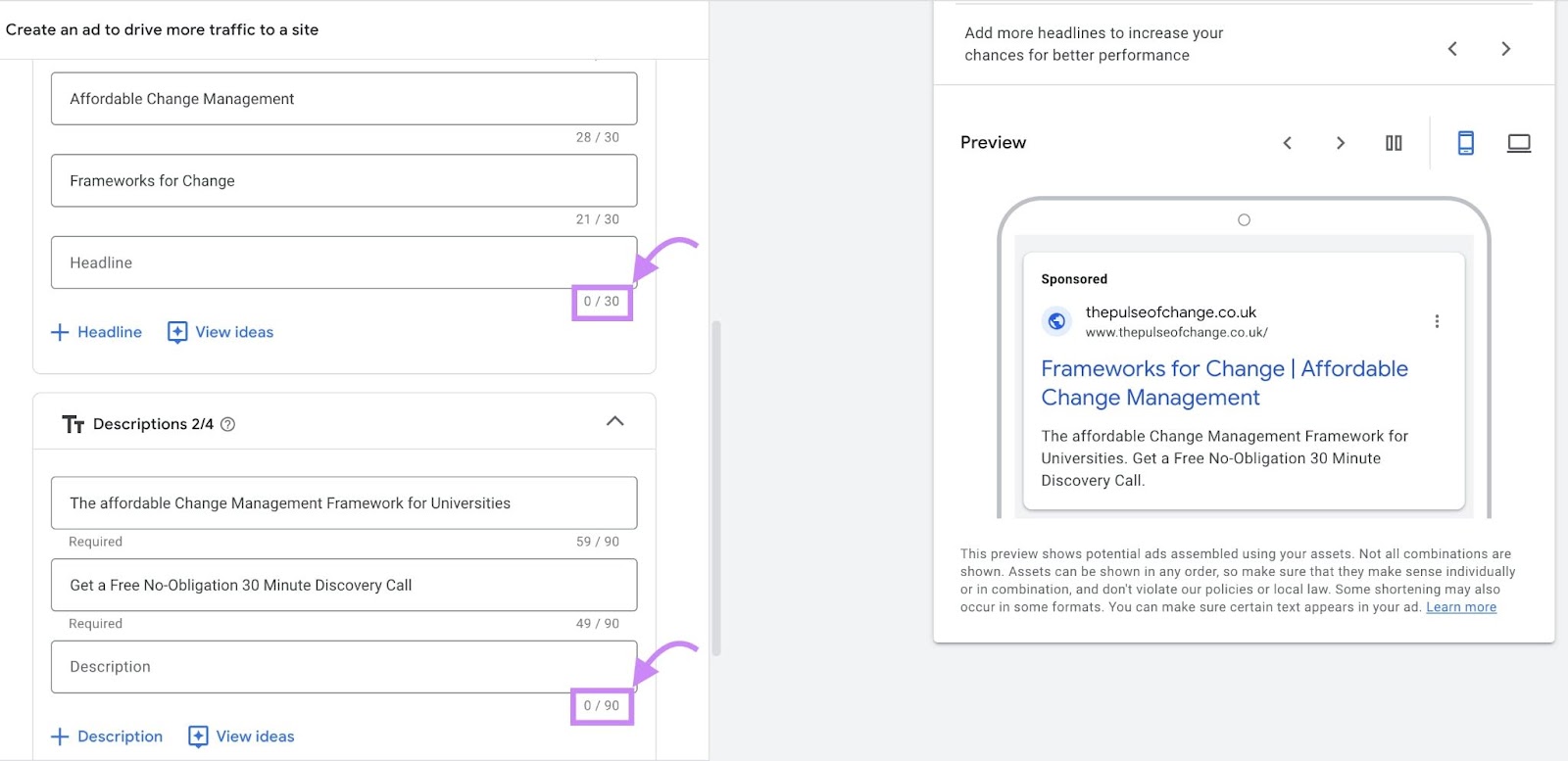
The goal is to quickly hook in readers with concise but persuasive copy.
And you can look at your competitors’ ad copy as a reference point.
Go to the Advertising Research tool, enter a competitor’s domain, and click “Search.”

You’ll see something like this:
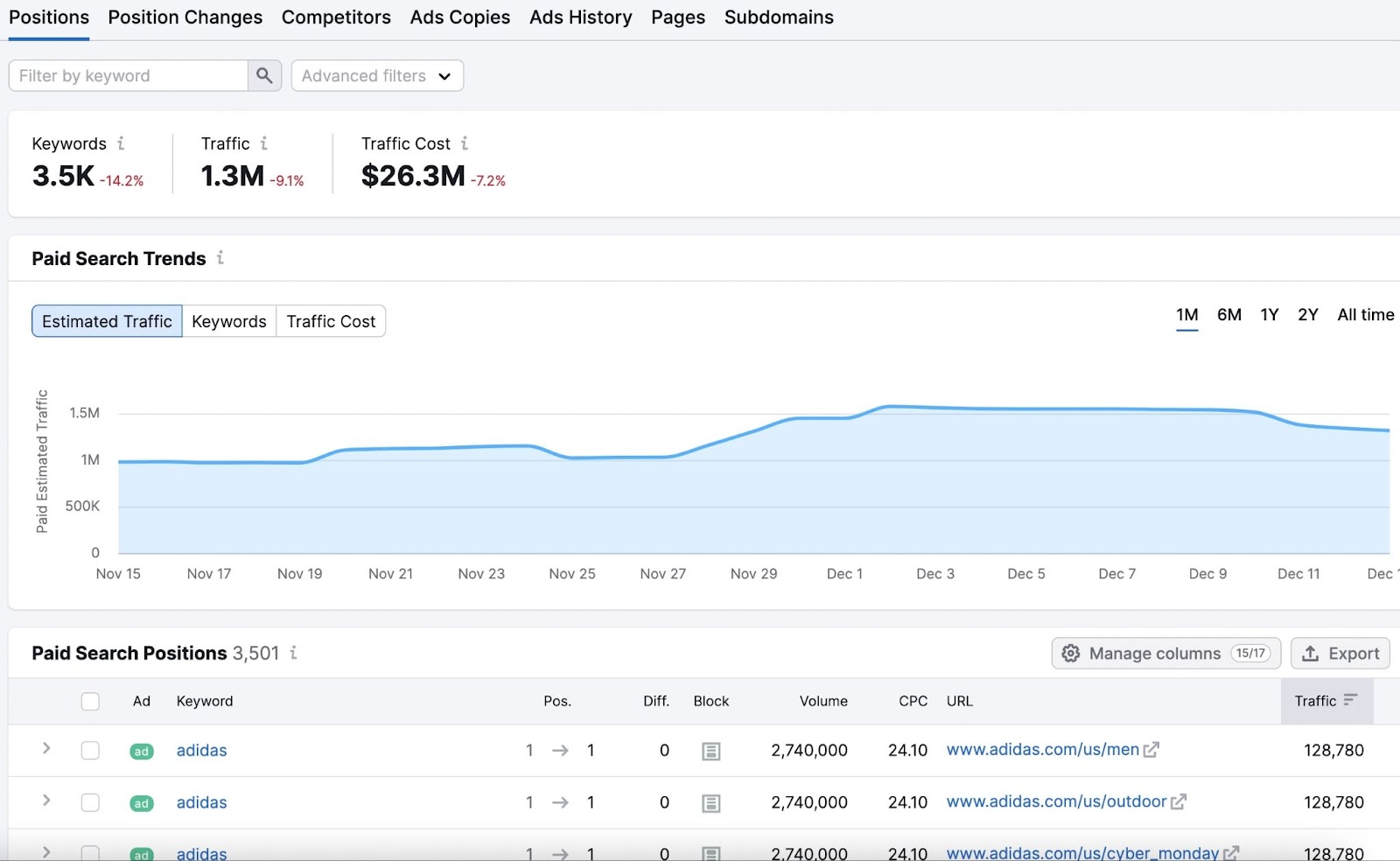
Head to the “Ads Copies” tab.
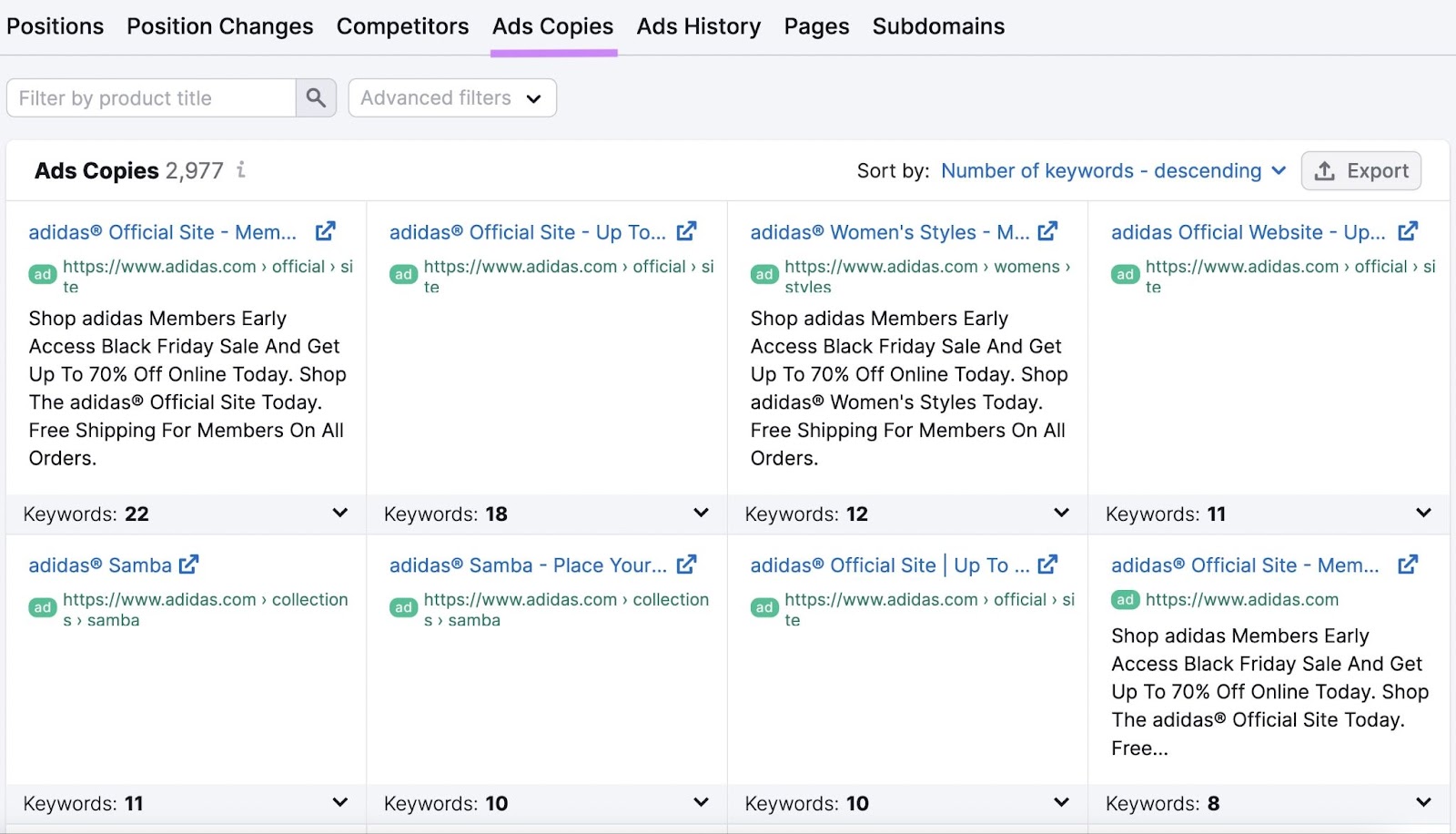
Here, you’ll find all the Google search ads your competitor is running.
Analyze the copy. Check the messaging and calls to action (CTAs), take inspiration, and create your own unique ads.
5. Remaining Ad Settings
In this phase, you’ll finish setting up your campaign. Which includes adding the keywords you identified earlier.
It’s worth pointing out that you set different keyword match types to determine which keywords will trigger your ads. Here’s a brief overview of the three types:
- Broad match: Ads could show on searches related to your keyword
- Phrase match: Ads could show on searches that include either the meaning or the implied meaning of your keyword
- Exact match: Ads could show only on searches with the same meaning or intent of your keyword
You’ll also set a budget for how much you’re willing to spend on the campaign. And a schedule for how long the campaign will run. So you can control your advertising spend and evaluate the campaign’s performance over a specific period.
PPC Pros
It Gives You Immediate Traffic and Results
When it comes to paid search vs. SEO, the former has the immediacy advantage. Your ads can attract clicks as soon as they go live.
This immediacy is great for new product launches or promotions.
It Provides Flexibility and Testing
With PPC, you’re in the driver’s seat. You can set your budget, choose your keywords, and select your target audience.
You can also conduct A/B tests (comparing two versions to see which performs better) with different ad formats, messages, and promotions to see what captures users’ attention and gets them to take action.
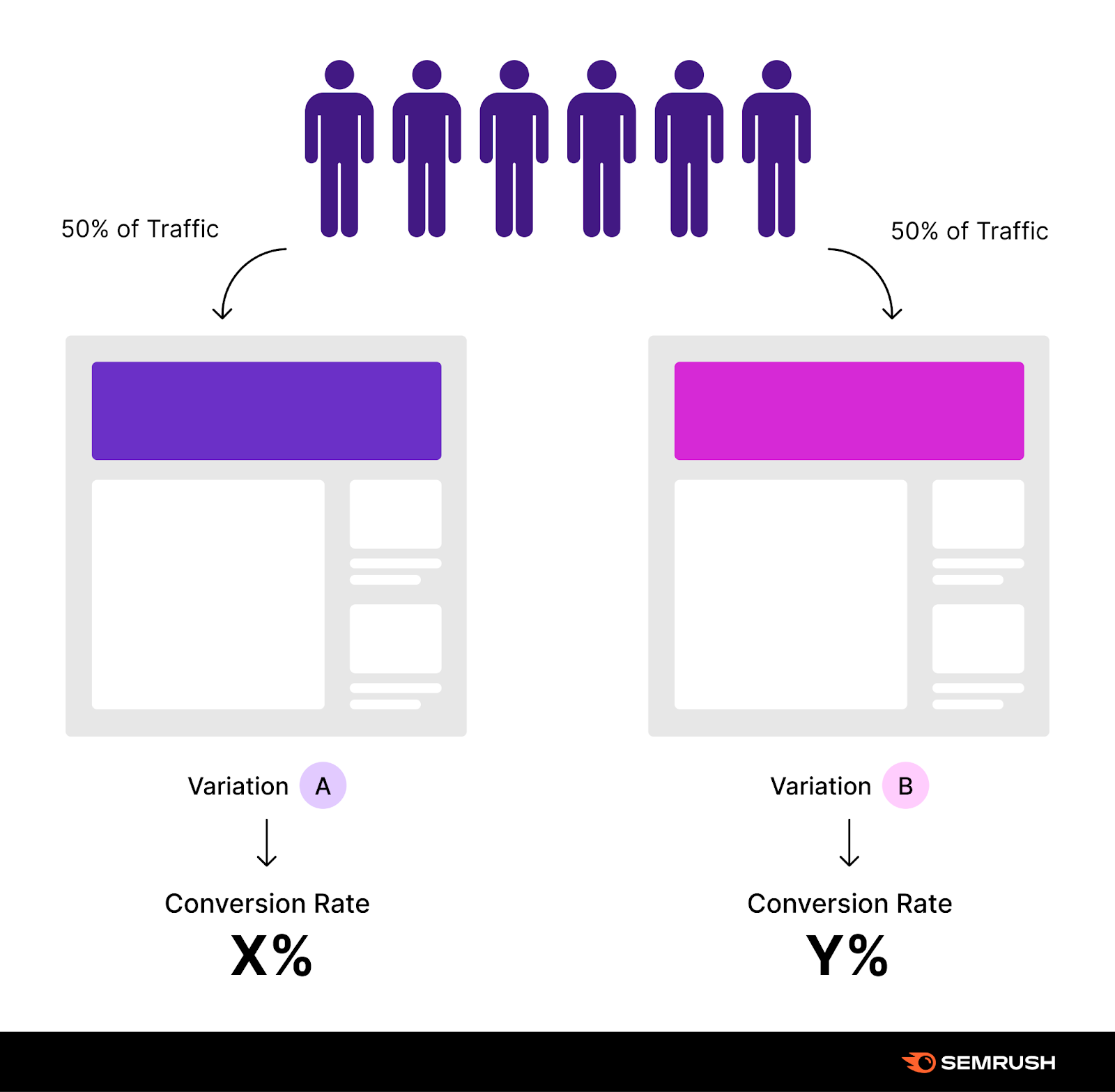
This level of control and flexibility allows for rapid experimentation and optimization, helping you quickly find the most effective approach for your advertising goals.
It Can Easily Be Measured
One of PPC’s key advantages is how easy performance measurement is. You can track clear metrics, such as how many people saw your ads, how many people clicked on them, and how many users took the desired action.
This makes it easy to adjust if you’re not seeing the results you want.
And if you use A/B testing, you can more readily identify what works. Which allows you to replicate success in future ads.
PPC Cons
It Can Be Tricky to Implement
Setting up a successful PPC campaign requires a deep understanding of various factors, like keyword research, ad copywriting, and targeting options.
And just learning how to use platforms like Google Ads can be challenging. Especially with frequent feature and interface changes.
So, managing a campaign can be overwhelming. Particularly when you consider that even small mistakes in setting up campaigns (such as misconfiguring targeting options) can lead to wasted ad spend.
You can hire specialists to manage your campaigns to reduce the risk, but it will add to the overall cost.
It Requires a Continual Investment
When your PPC ad spend stops, so do your results.
Unlike SEO content that often continues to draw visitors long after the work is done, PPC doesn’t offer lasting results without an ongoing investment.
This immediate halt in traffic, conversions, etc. can be a significant drawback for businesses that rely on consistent online visibility.
It Can Get Expensive
Bidding on popular keywords in PPC can quickly drain your marketing budget.
Why?
Because many businesses are bidding on the same keywords.
This competition inflates the CPC. For instance, the average CPC for “online business degree programs” is $37.89.
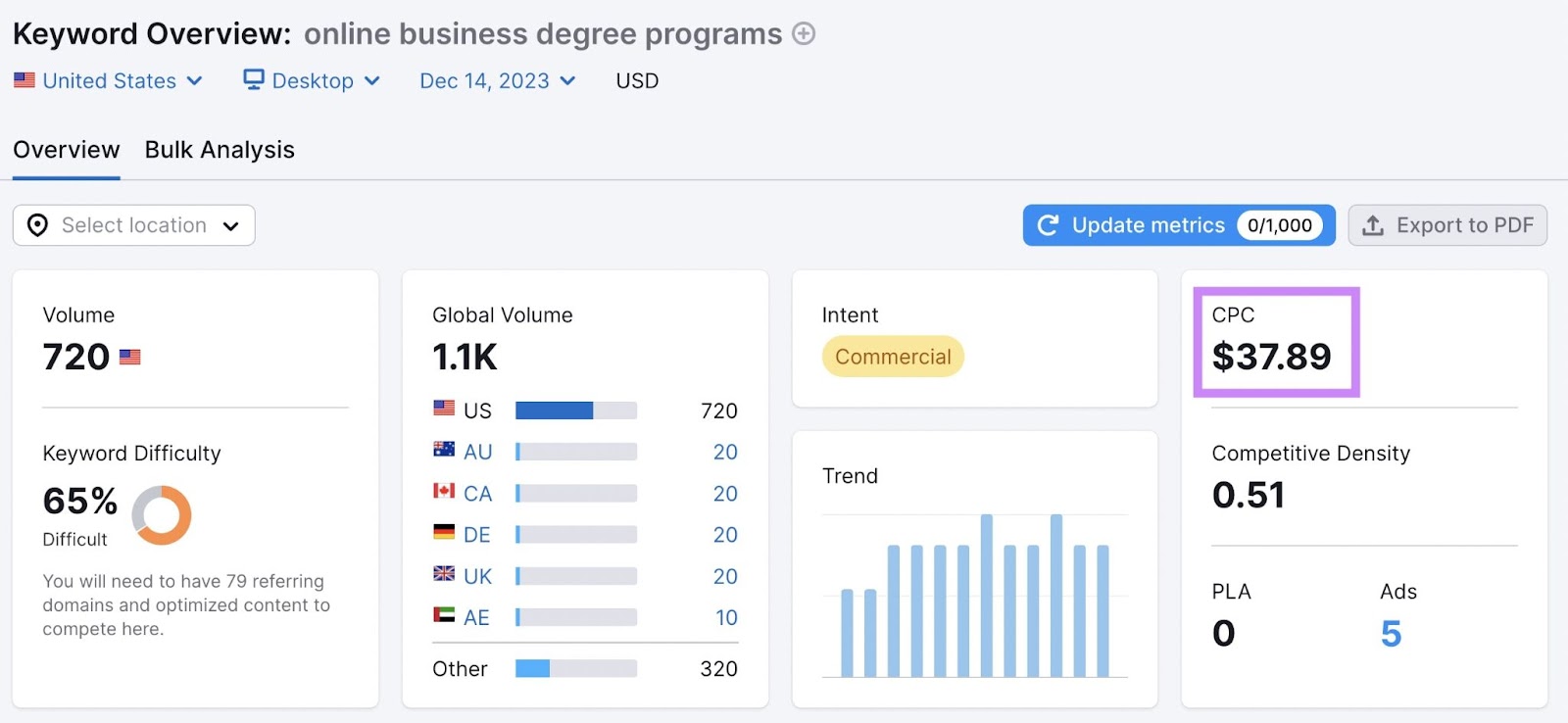
A high CPC like this makes it challenging to maintain a positive ROI, especially for small businesses or those with limited ad budgets.
To avoid overspending, you might target more niche keywords. But that could reduce your ad’s visibility and potential reach.
It Has Strict Guidelines
PPC search ads come with stringent character limits and format restrictions.
While these restrictions help with clear messaging, it also means there’s less room for storytelling and brand personality.
This limitation can make it difficult to stand out in a crowded ad space.
SEO vs. PPC: Which Should You Use?
Neither is inherently better than the other in the SEO versus PPC comparison. They both have their own strengths that make them ideal for specific use cases.
The real question isn’t whether you should use one or the other. But when you should use them in your search engine marketing strategy.
When to Use SEO
SEO might be right for you if:
You Have a Tight Budget
SEO is usually quite cost-effective in the long run.
While getting your content to rank may take time and effort, you don’t have to pay for each click as you would with PPC.
For example, a new tech startup might struggle to afford the high CPC for popular tech keywords. But it can grow its audience through SEO by creating compelling content that ranks organically for niche, long-tail keywords.
Building Brand Authority Is a Priority
Regularly appearing in organic search results can help your brand become a recognized authority in your industry.
For instance, a consulting firm that consistently ranks for industry-related searches is likely to be seen as more credible than one that no one has ever heard of.
Further reading: How to Build Topical Authority (and Why It Matters)
You’re Focused on Long-Term ROI
SEO can provide a steady stream of traffic.
And if you’re following basic optimization principles (like updating content regularly, incorporating keywords thoughtfully, and more), you can sustain those results for years.
Here’s a chart from Domain Overview that shows how long it took Lululemon to gain traction with SEO. And how their traffic has sustainably grown:

You Want to Reach Users at All Funnel Stages
With SEO, you can create a variety of content that targets users from the top of the funnel (when they become aware of your product or brand) to the bottom of the funnel (when they become ready to purchase).
For example, a hardware store might create DIY guides to attract early-stage users. But craft product comparisons for those closer to making a purchase.
Further reading: How to Build an Effective Content Marketing Funnel [Study]
When to Use PPC
PPC might be a good fit for you if:
You Want Immediate Visibility and Conversions
You can instantly get in front of relevant users with PPC ads. Which helps boost your leads and conversions.
For instance, if you’ve just launched an environmentally friendly shampoo, a PPC ad can ensure your product appears prominently when potential customers are searching for personal hygiene products—even if they aren’t aware of your brand yet.
You’re Running Time-Sensitive Campaigns
SEO won’t be fast enough if you’re promoting an event or a limited-time offer.
PPC shines in these cases by providing immediate exposure.
A classic example is using PPC ads to advertise a Black Friday sale to drive as much traffic as possible at the right time.
Like this Macy’s ad:
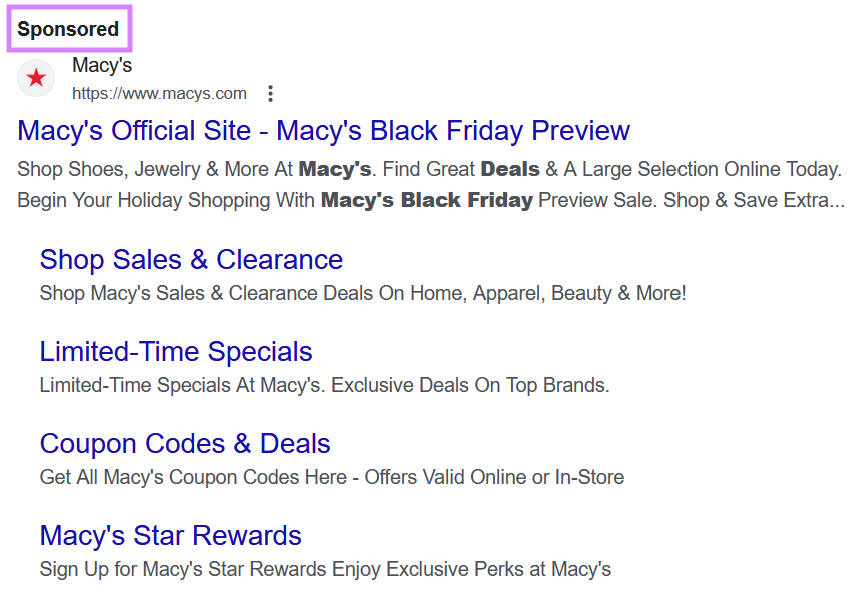
You’re Targeting a Specific Audience
PPC platforms offer robust targeting options, letting you show your ads to users based on demographics, interests, and behaviors.
This means you can easily show your ads only to the type of person you expect will be interested in your product or service.
For example, a luxury car dealership might target its ads to users who have shown an interest in luxury goods and have a higher income level.
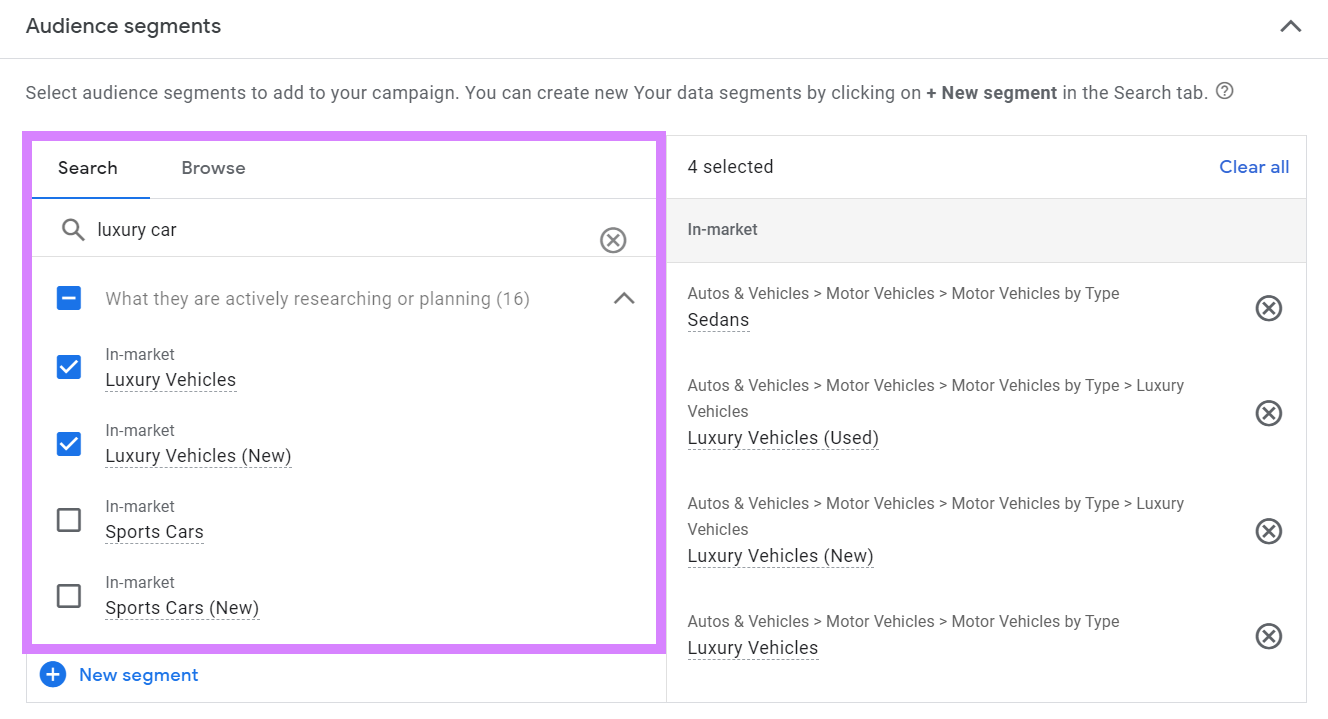
While SEO allows you to target specific personas and create tailored content based on thorough research, you have less control over who actually sees your content.
You’re Testing Marketing Strategies
PPC ads provide real-time feedback on what attracts and resonates with your target audience.
They can serve as a testing ground for various aspects of your marketing approach.
You might use PPC to determine which CTA phrases lead to more conversions or which promotional offers people like the most.
This immediate data can inform your broader marketing strategy. Helping you refine your approach and make sure that when you do invest in more extensive campaigns (paid or organic), they’re backed by objective insights to drive the best possible performance.
SEO offers less immediate feedback due to its longer-term nature. And SEO-related changes, such as altering content or keywords, take time to show results in search rankings and user responses.
Further reading: How to Create an Effective PPC Strategy in 7 Steps
Build an Integrated Search Engine Marketing Strategy
Instead of considering just PPC vs. SEO, focus on both. So you can benefit from long-term, sustainable growth and immediate results.
A good way to begin is to look at your competitors and see how they approach organic and paid search campaigns.
Use Semrush’s Domain Overview for a comprehensive report that shows information about their SEO and PPC efforts.
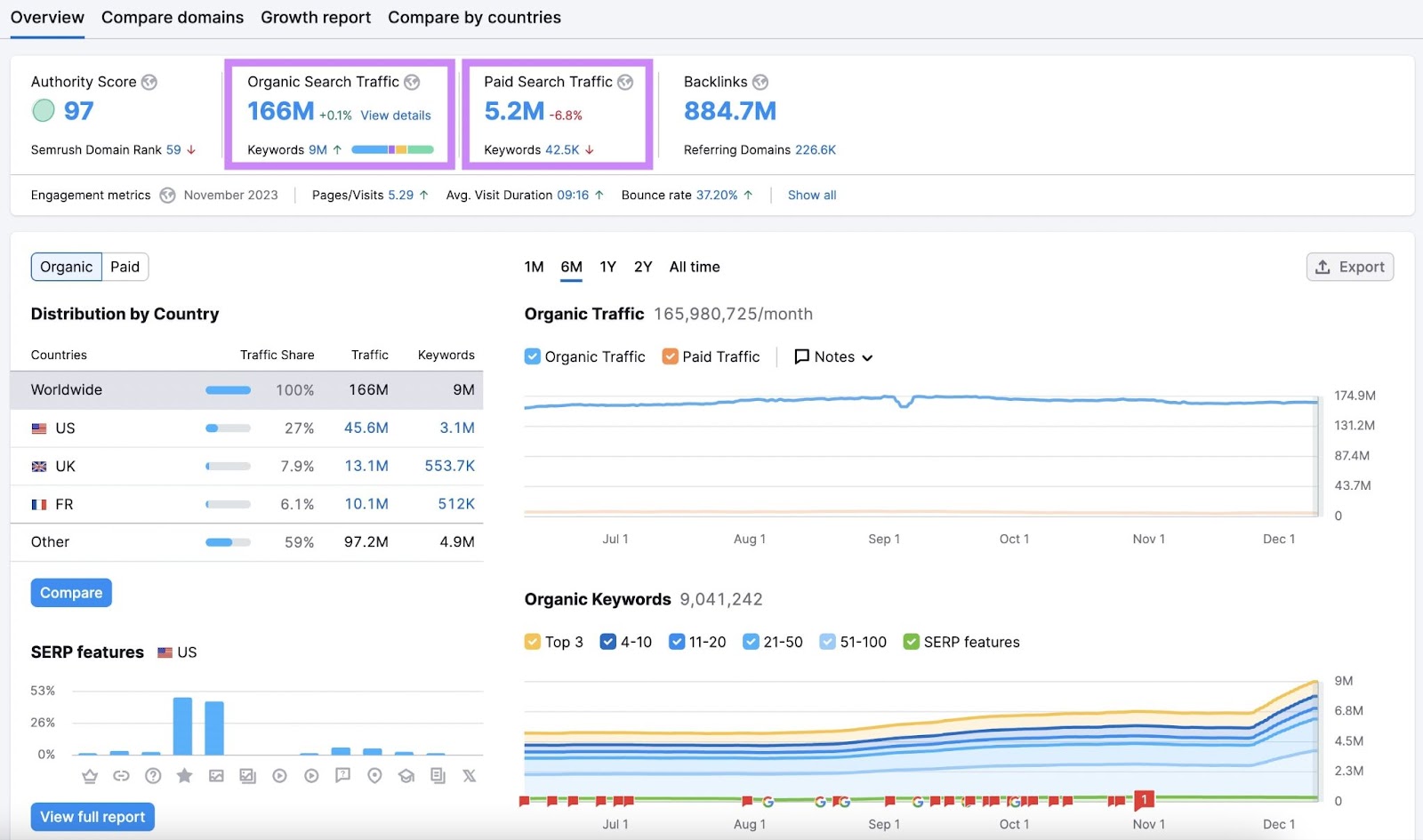
You can compare up to five domains to gain insights into each brand’s strengths and weaknesses. And use that information to jumpstart your SEO and PPC strategies.
Try Domain Overview for free.
Source link : Semrush.com
